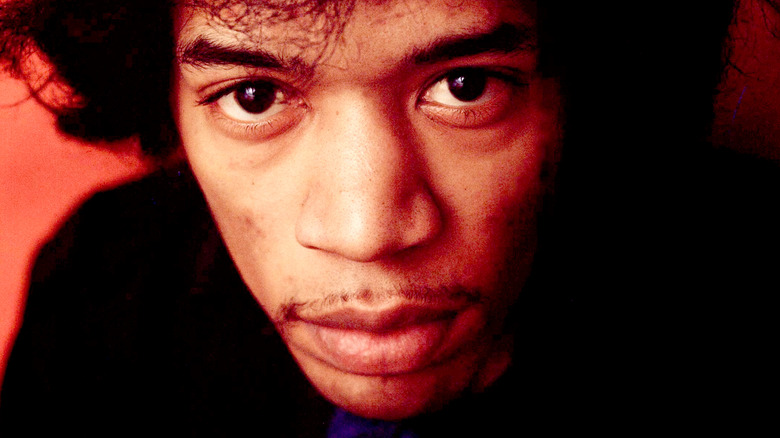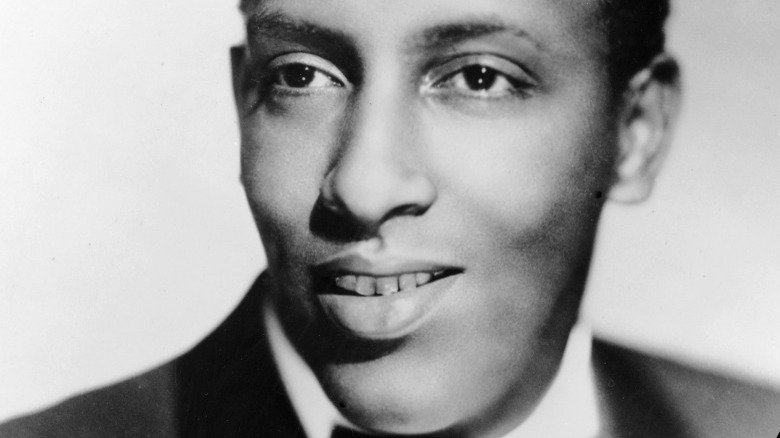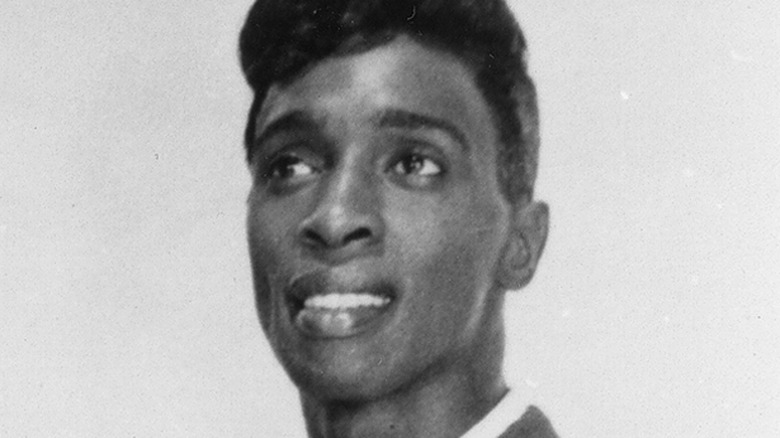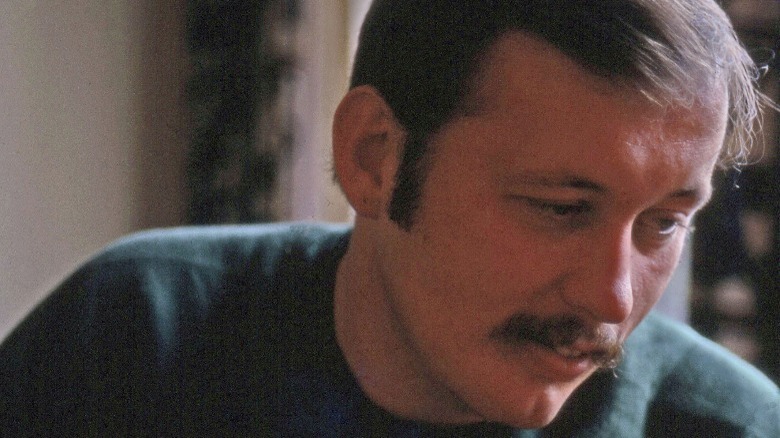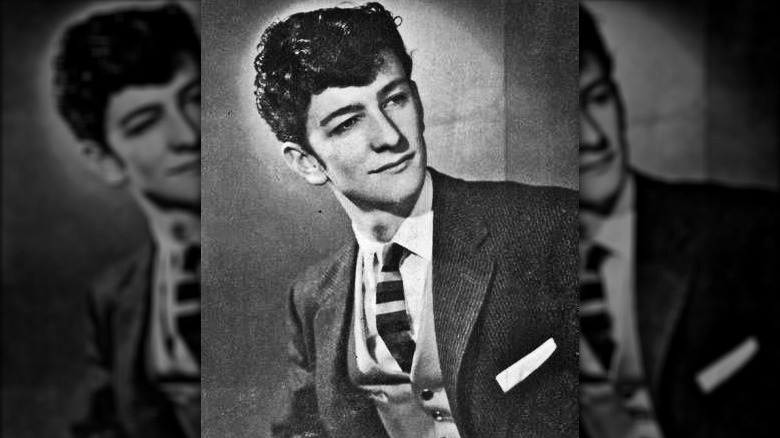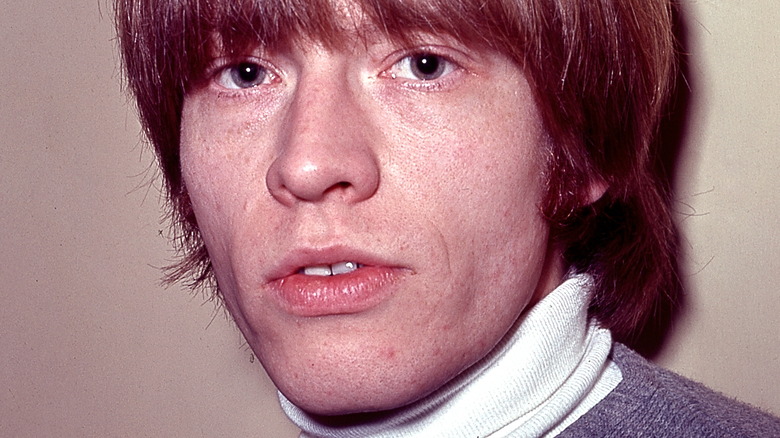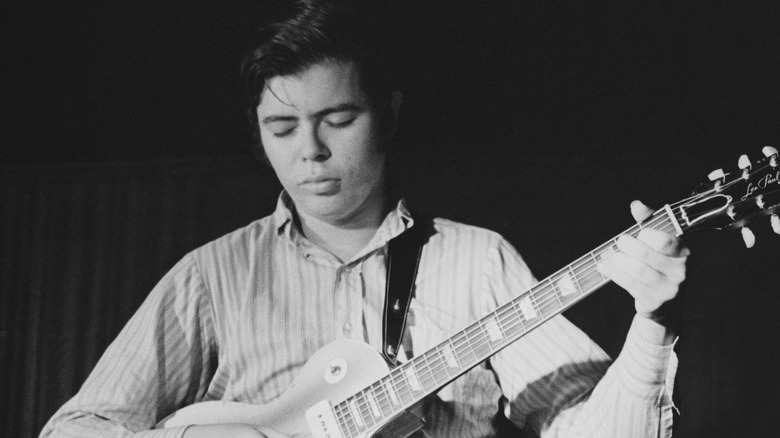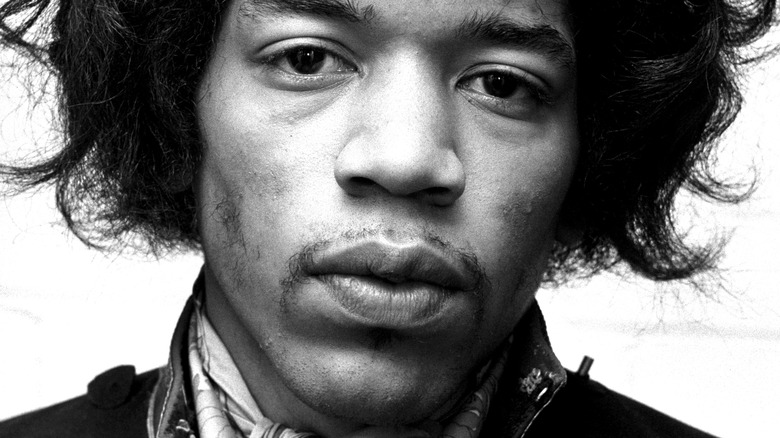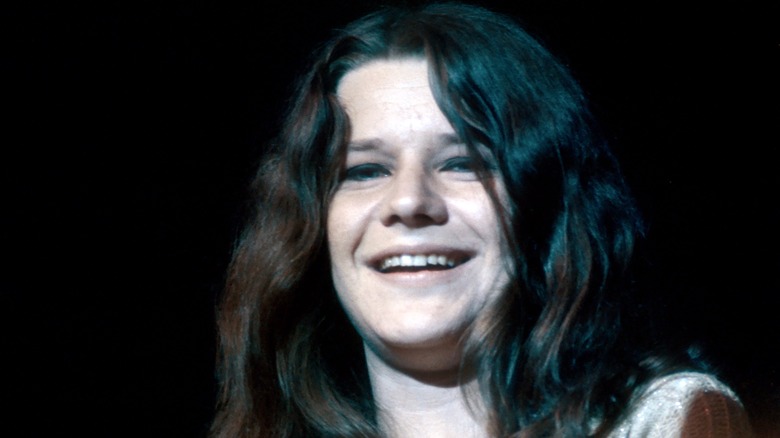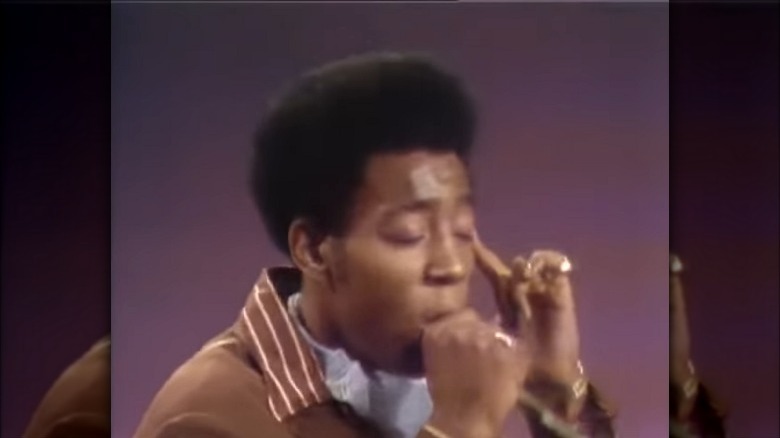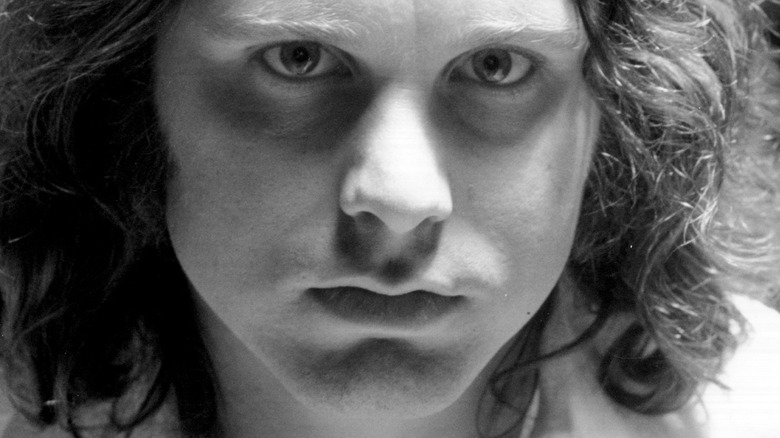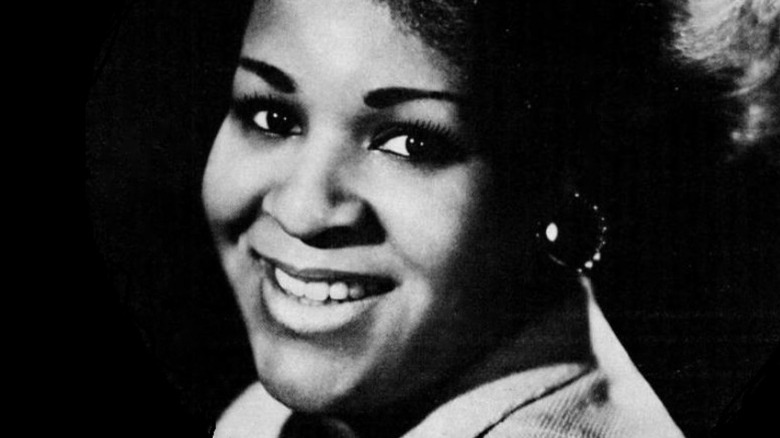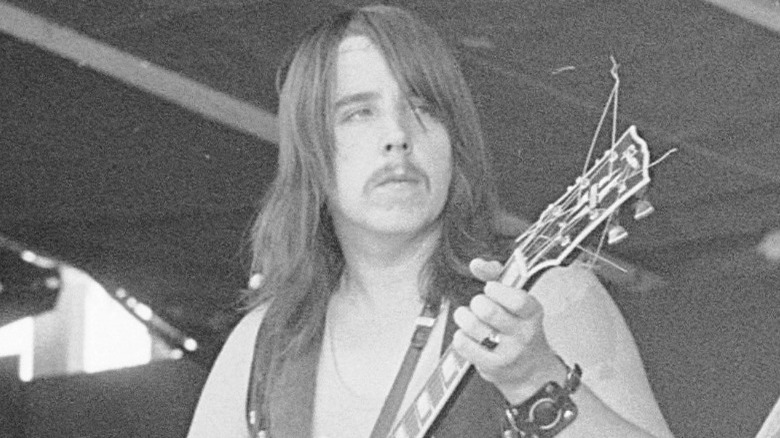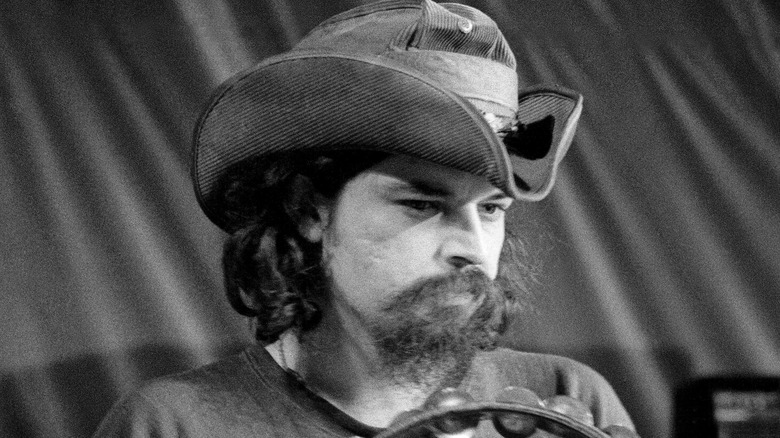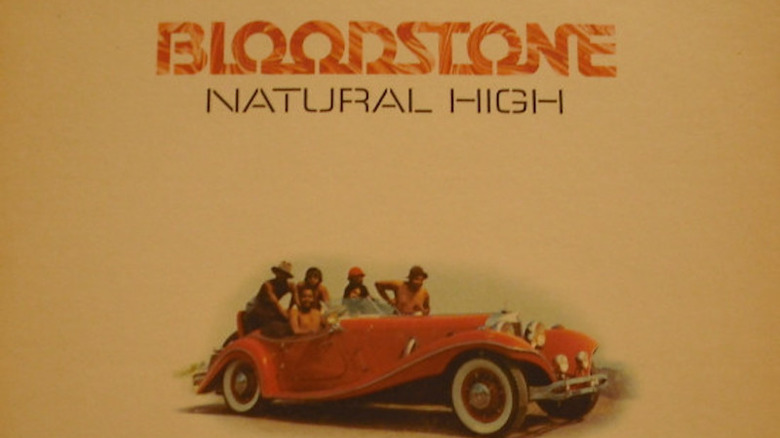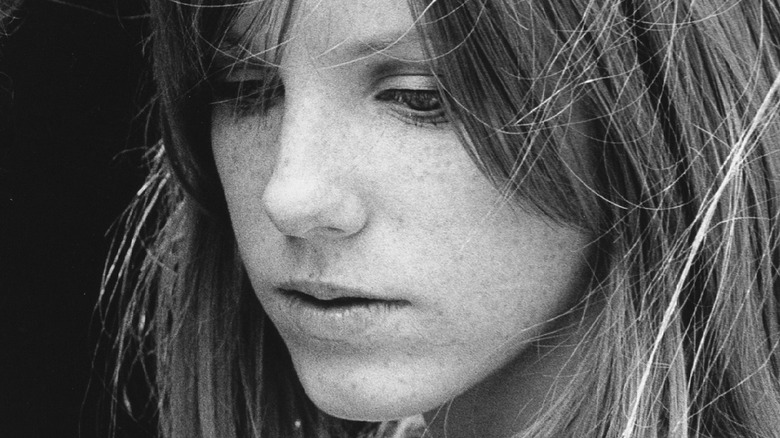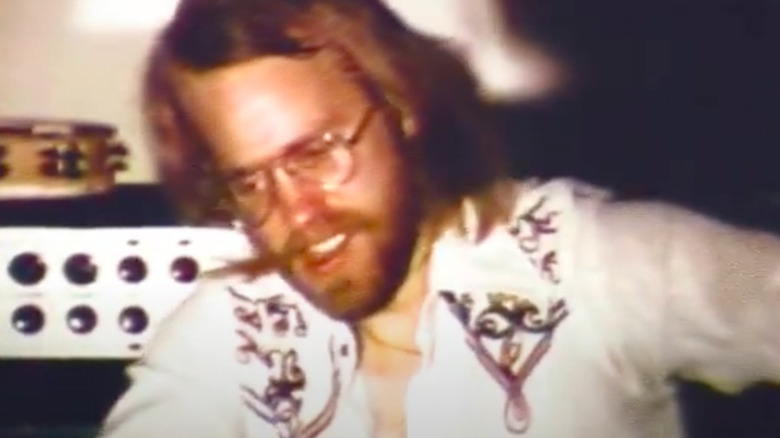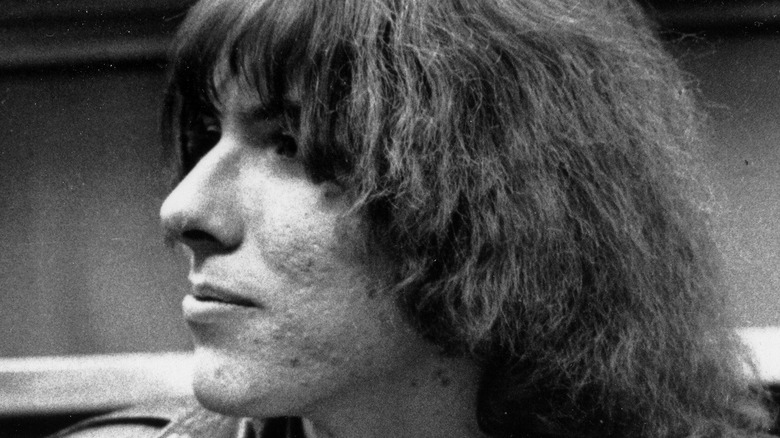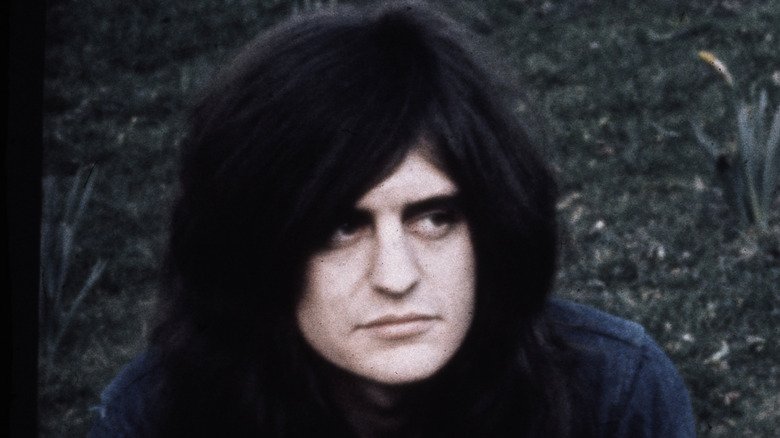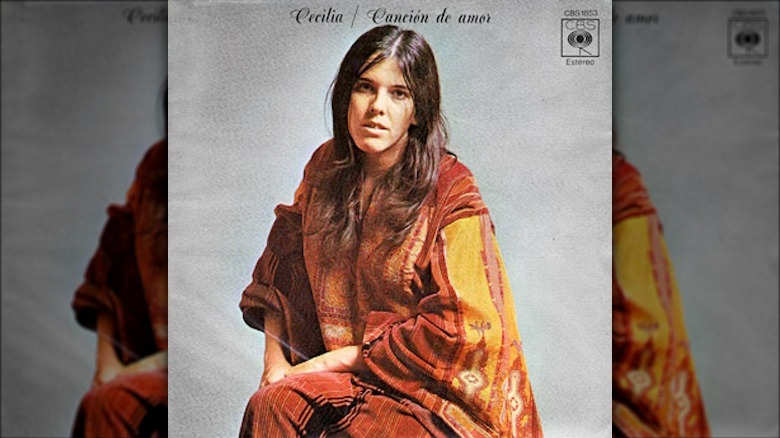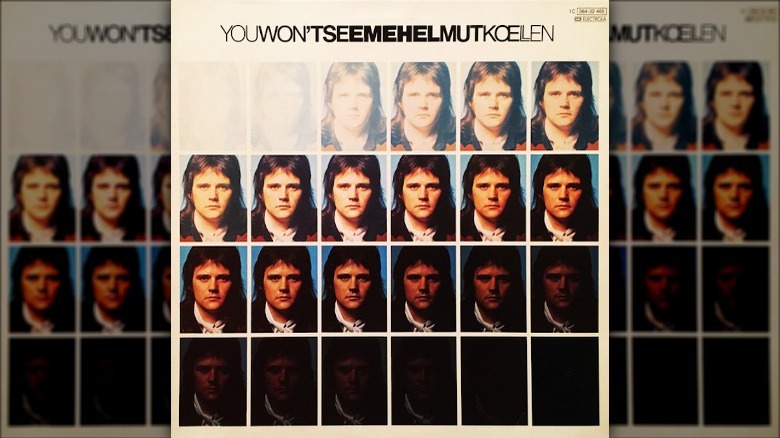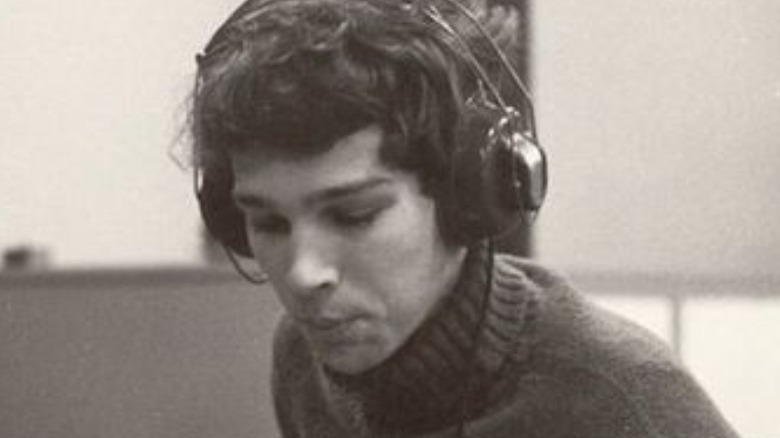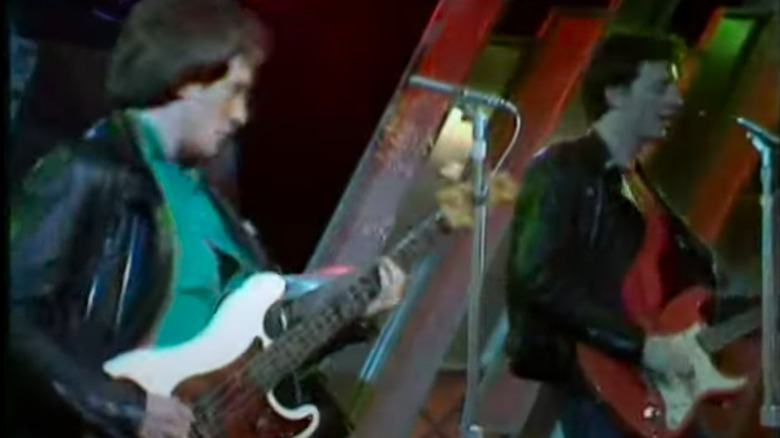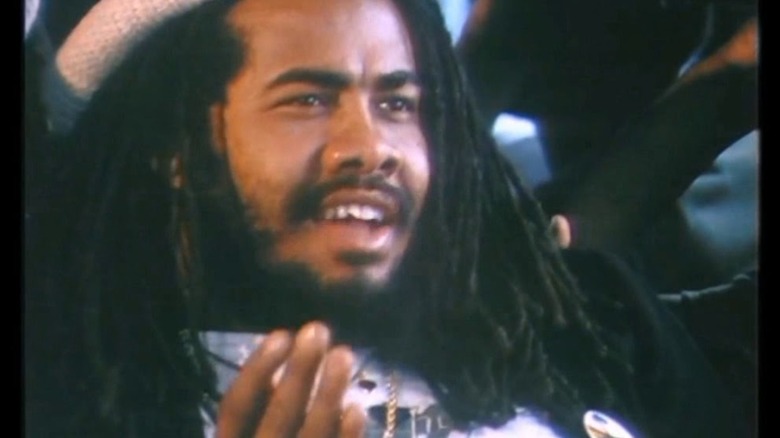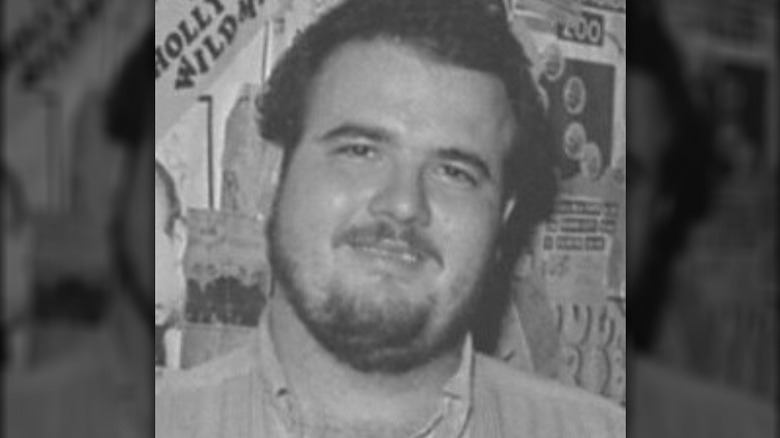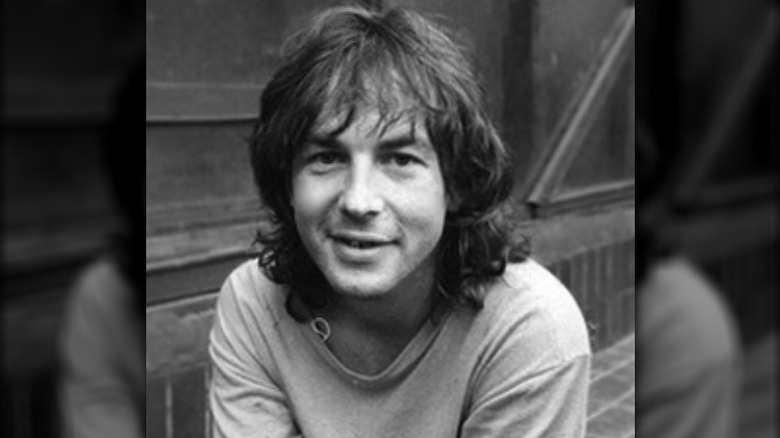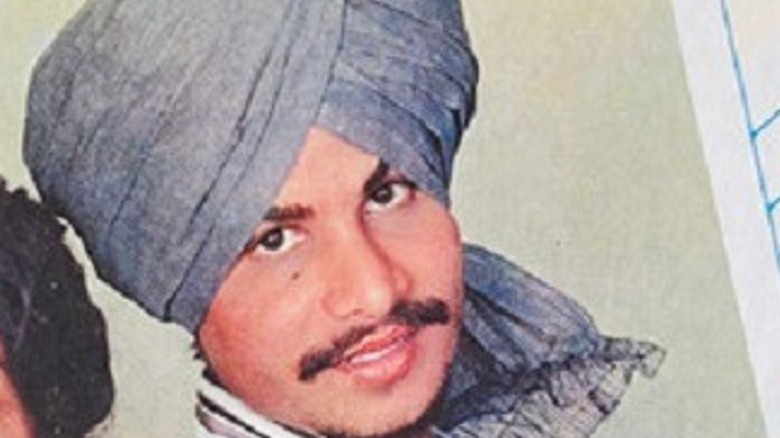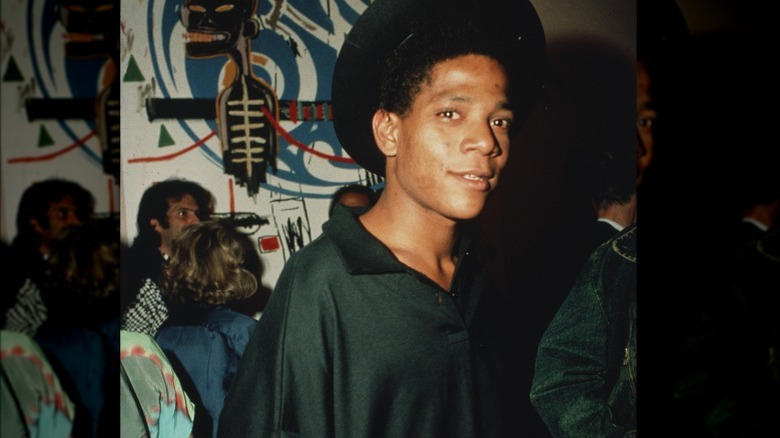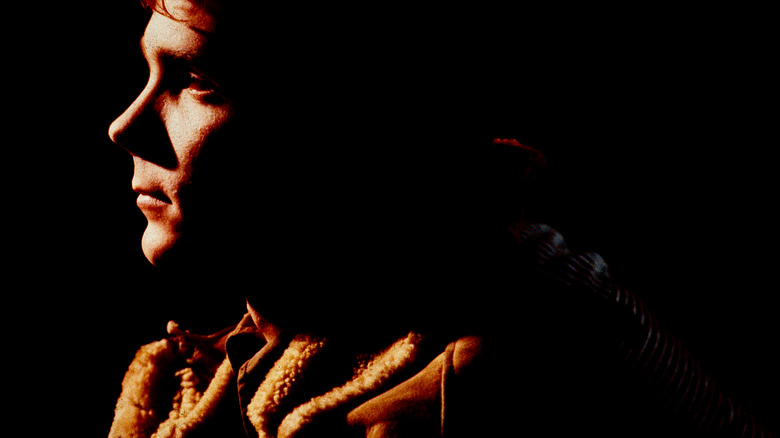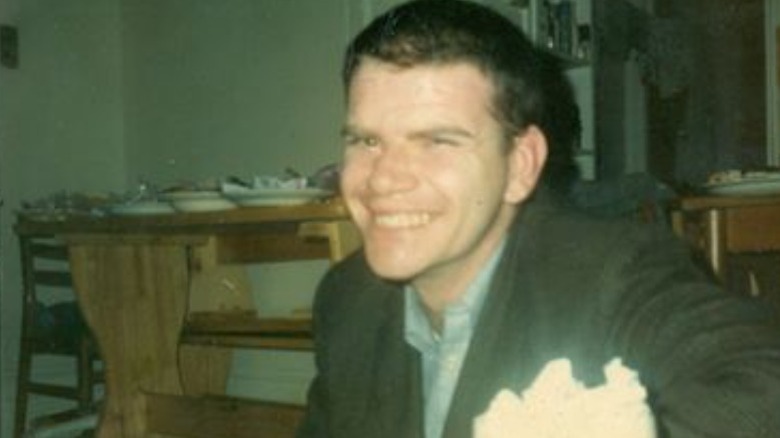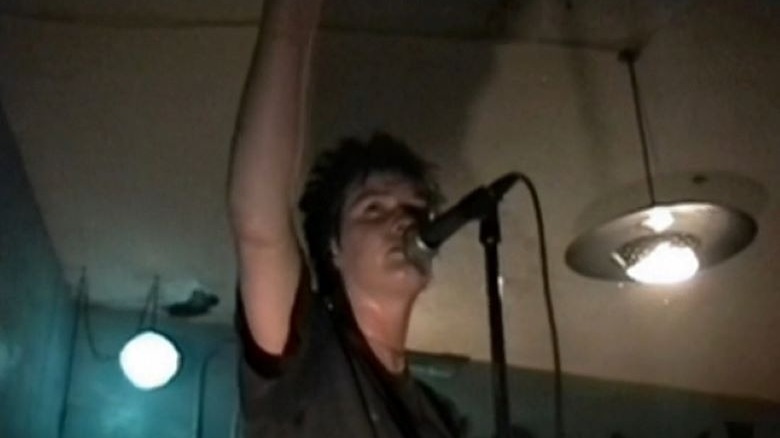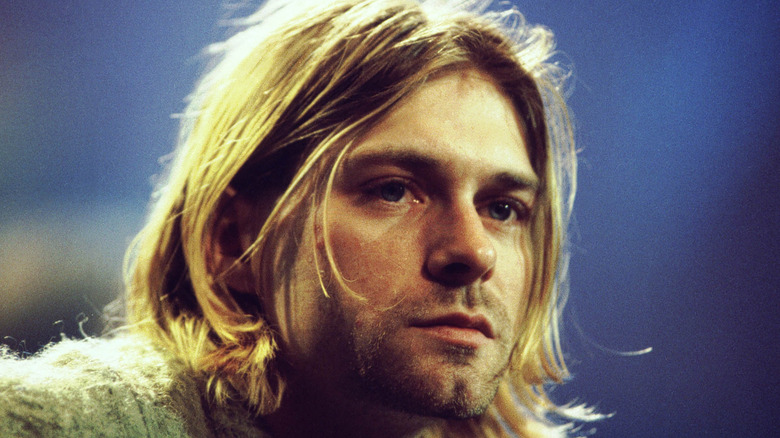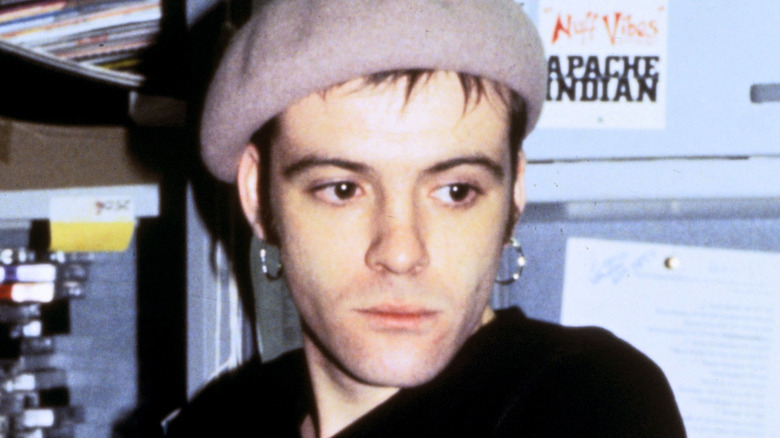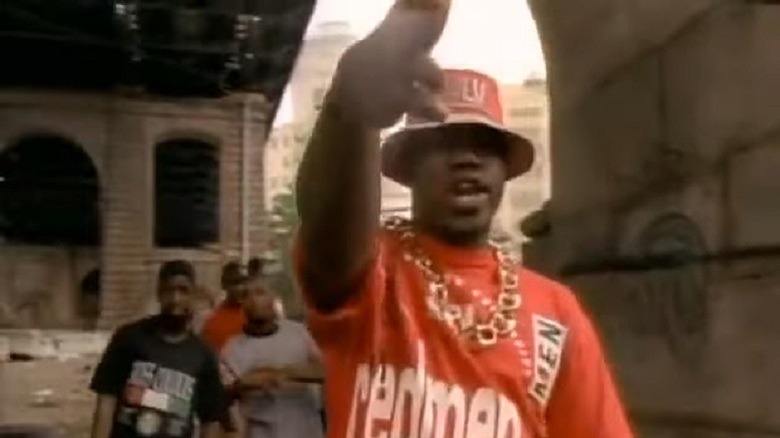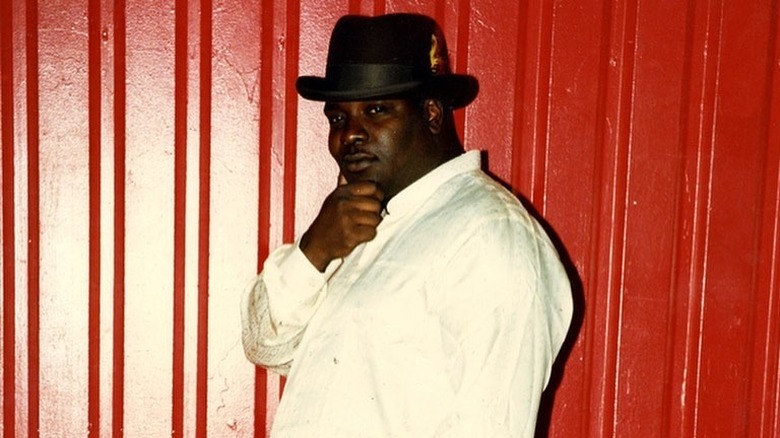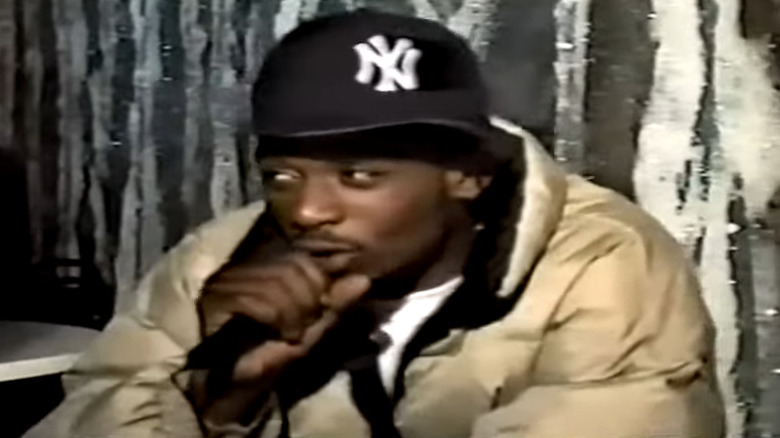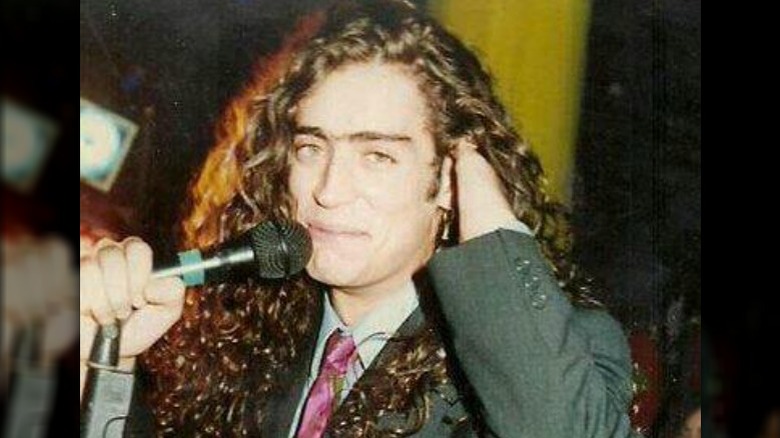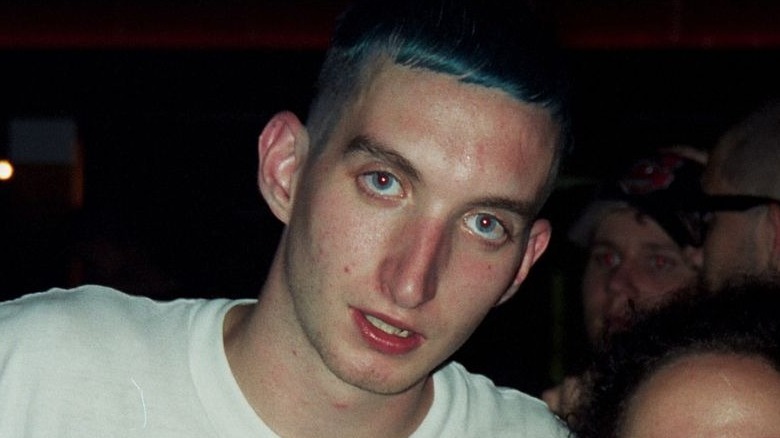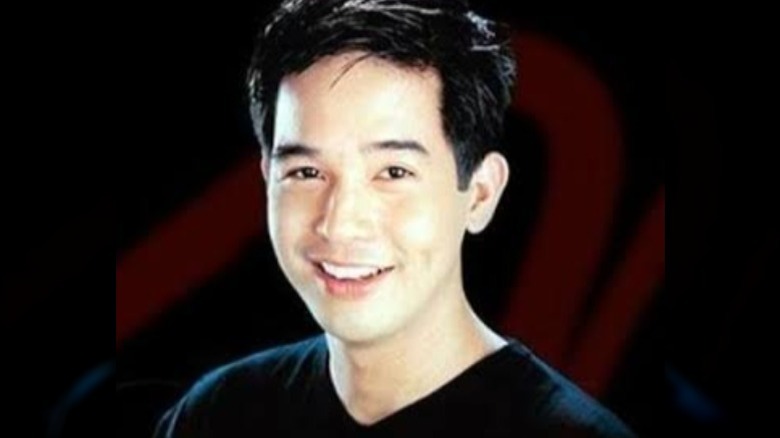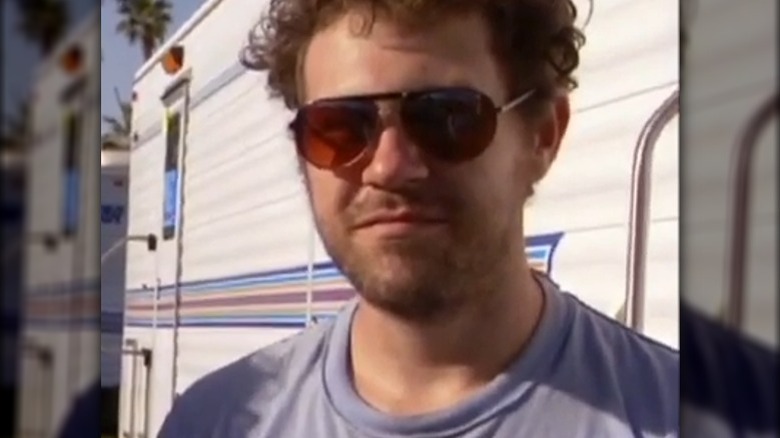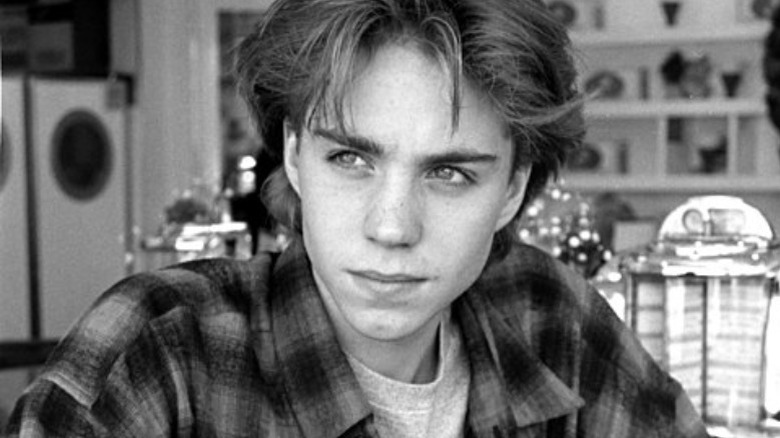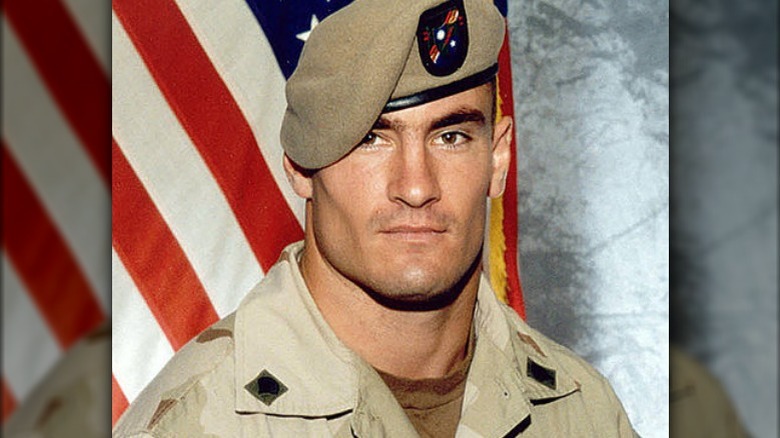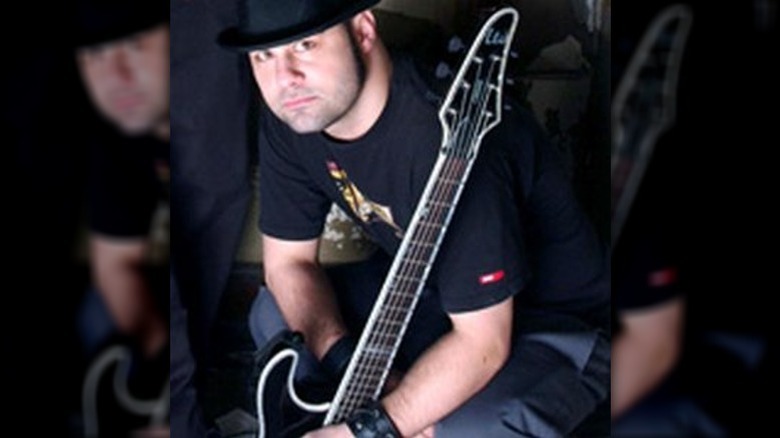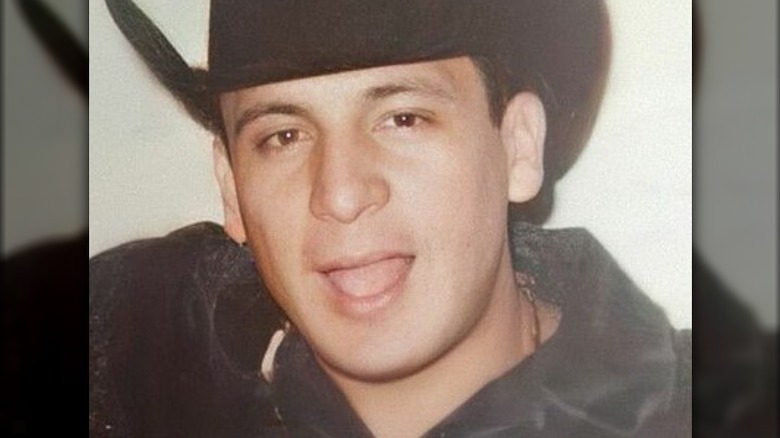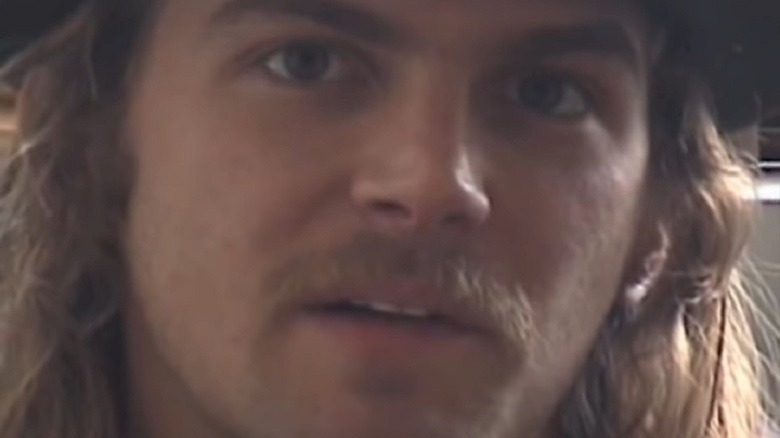All The Unfortunate Members Of The 27 Club
The following article includes references to suicide, sexual assault, murder, drug, and alcohol abuse.
The 27 Club is a list of celebrities who share one tragic thing in common: they all died at the age of 27. Now, people die all the time for a variety of reasons, but when it happens to a celebrity, folks take notice. When it keeps happening, year after year, folks tend to get a little suspicious. This is how the informal list known as the 27 Club came about; people began noticing a lot of their favorite actors, musicians, artists, and other celebs were dropping like flies at the same age.
While there's no widespread conspiracy about this sort of thing, it does come off as a suspicious coincidence. That's because it truly does keep happening. According to History, the concept of the 27 Club began in the early 20th century, with blues singer Robert Johnson's death being considered the first unofficial member of the 27 Club. After he died in 1938, people began to notice a trend that sadly continues to this day. Hardly a year goes by that someone doesn't tragically get their name attached to the list, and they die for all kinds of reasons.
While the concept dates back to the early 20th century, this article takes a look at the celebrities who died at the age of 27 from 1960 and beyond. The resulting list is long, as dozens of people meet the criteria. These are all the members of the 27 Club, listed in order by date of demise, beginning in 1960.
Jesse Belvin
Jesse Belvin was a popular singer/songwriter who specialized in R&B and soul music throughout the 1950s. According to Mojo, he is one of the artists credited with writing The Penguins' hit, "Earth Angel," which regained popularity in 1985 via "Back to the Future." Throughout the 1950s, Belvin wrote, sang, and sold songs recorded by himself and other artists. Eventually, he signed with RCA Records in 1959, which considerably elevated his industry standing. That same year, he scored a top 40 hit with "Guess Who."
"Guess Who" was developed from a love letter his wife sent him, and it turned into a hit. His biggest hit is arguably "Goodnight My Love," which rose to the number seven slot on the R&B chart in 1956. His style was popular, and he influenced a number of successful artists who followed him, including Sam Cooke, Nat "King" Cole," and many others. In his final concert, Belvin appeared alongside Cooke, Marv Johnson, and Jackie Wilson in Little Rock, Arkansas, on February 6, 1960.
The concert was interrupted twice by local white teens yelling racial epithets at the Black performers, per Mojo. When the concert ended, Belvin and his wife, Jo Ann, were driving outside Hope, Arkansas, when they got into a head-on collision. The Belvins were both killed, as was the other driver. The accident appeared suspicious at the time, and the police believed Belvin's car was tampered with. Despite this, no arrests were made, and his death was ruled an accident.
If you or a loved one has experienced a hate crime, contact the VictimConnect Hotline by phone at 1-855-4-VICTIM or by chat for more information or assistance in locating services to help. If you or a loved one are in immediate danger, call 911.
Rudy Lewis
Rudy Lewis was a popular R&B singer in the 1950s and early '60s. He started out singing gospel with the Clara Ward Singers before joining The Drifters in 1960 as the band's lead singer in its third composition. The band's name was appropriate, as it consisted of dozens of different musicians throughout the years. When Lewis joined the group, he replaced Ben E. King, and years later, Lewis would be replaced by Johnny Moore. While performing with The Drifters, Lewis recorded several hits with the band, including "Please Stay," "Up on the Roof," "On Broadway," and many more.
Lewis also recorded several solo tracks, but these never did as well as the group performances, which pushed The Drifters to new heights. One of the band's best-known tunes, "Under the Boardwalk," was set to record on May 21, 1964. Unfortunately, Lewis was found dead in his hotel room before the recording session. The cause of death was never determined, as no autopsy was performed.
It was believed that Lewis died from a drug overdose, but conflicting theories suggest his death was the result of asphyxiation or a heart attack (via All Music). Whatever the cause, Lewis was dead at 27. The band rescheduled their session for the following day and laid down "Under the Boardwalk," with Johnny Moore providing the lead vocals.
If you or anyone you know needs help with addiction issues, help is available. Visit the Substance Abuse and Mental Health Services Administration website or contact SAMHSA's National Helpline at 1-800-662-HELP (4357).
Joe Henderson
Joe Henderson (seen here) was an R&B singer who started out singing gospel in Gary, Indiana (via Way Back Attack). He spent his career recording numerous tracks that gained popularity throughout the early '60s. His most well-known track, "Snap Your Fingers," charted in both R&B and pop, which helped him gain attention as a burgeoning artist. The success of that track led to additional fame via "The Searching is Over," "You Take One Step (I'll Take Two)," and others.
Unfortunately, the latter track was Henderson's final hit, as he passed away soon after its release. Shortly after recording "You Take One Step (I'll Take Two)," Henderson died from a heart attack at his apartment in Nashville, Tennessee. At the time of his death, Henderson had recently recorded several tracks for RIC Records, and he was doing well professionally.
While he was a beloved singer during his life and was on the verge of breaking out into a soul career, Henderson's work wasn't compiled until October 2021. Many of Henderson's songs have been covered by the artists who followed him. In 1987, Ronnie Milsap released a cover of "Snap Your Fingers," which topped the country charts. Unfortunately, Henderson's work only lasted a short time before his death, but his rise was meteoric, as was his demise, which came far too soon.
Malcolm Hale
Malcolm Hale was the lead guitarist and trombonist for Spanky & Our Gang. The band formed in 1966 around Elaine "Spanky" McFarlane and the popular "Our Gang" comedies from the 1930s. The band released a number of hits while it was active, including "Making Every Minute Count," "Sunday Will Never Be The Same," "Lazy Day," and many more. Spanky and Our Gang remained active (and popular) for two years, but the band disbanded in 1968 following a tragedy.
On October 31, 1968, Hale was found dead in the home of friends in Chicago, Illinois; he died of bronchial pneumonia. A faulty heater in his room elevated carbon monoxide, resulting in his death. In his obituary, Hale was described by Robert Shelton of The New York Times as "A mustached gamester in a Carnaby Street shirt." Spanky & Our Gang was known for mixing comedic elements with the music, and Hale was especially good at this aspect of his performance.
After Hale's death, the band went on to fulfill its obligations and concert performances before deciding to disband the band. McFarlane was pregnant at the time, and replacing Hale wasn't something anyone wanted to do. Mercury released one more album following the break-up, and in 1975, Spanky & Our Gang was reformed as a country-western group. Despite the style change and lack of Hale, the new band was successful for a couple of years before the band disbanded once more.
Dickie Pride
A 16-year-old Dickie Pride was singing in a local pub when Russ Conway discovered him in the 1950s. According to AllMusic, Conway recommended him to Larry Parnes, who signed him after hearing him sing. He began performing live on stage, where he astounded audiences. His performances earned him the moniker "The Sheik of Shake." Before long, he signed with Columbia Records and dropped his first album, "Slippin n' Slidin," in 1959.
Pride's career began to stagger due to low record sales. Still, he continued to perform live, which often earned him acclaim. According to one of his former backup singers, Georgie Fame, Pride would jump off the stage and assault anyone who heckled him. This didn't help his reputation, but he continued to work into the early 1960s. He formed several bands in an attempt to stay relevant, but he lapsed into obscurity and became addicted to heroin.
In 1967, he was committed and lobotomized, which didn't help him reenter the music scene in 1969. In March of that year, he accidentally overdosed on sleeping pills (via AllMusic). At the time of his death, he had been out of the music scene for several years, and few noticed his passing. Yet, after his death, many artists once signed to Parnes' label, such as Joe Brown, claimed he was the most talented of them all.
If you or anyone you know needs help with addiction issues, help is available. Visit the Substance Abuse and Mental Health Services Administration website or contact SAMHSA's National Helpline at 1-800-662-HELP (4357).
Brian Jones
Today, when most people think of the Rolling Stones' lead, Mick Jagger comes to mind, but he wasn't always in that position. Brian Jones formed and named the band in 1962, and he played guitar, among other numerous instruments, while Jagger and Keith Richards composed most of the band's songs (via AllMusic).
As the Rolling Stones found success in the early 1960s, Jones found himself at odds with its manager, Andrew Loog Oldham, over the direction the band was taking. According to Far Out, when Jones formed the Rolling Stones, the band focused on British blues, but Oldham began steering it closer to rock, which was exploding in popularity at the time. As revealed by Variety, Jones' health began to decline, and his drinking and drug use skyrocketed. He showed up to recording sessions unable to play, and his contributions diminished significantly.
Jones was ultimately fired from the band he created in May of 1969, which didn't help his mental or physical health in any way. Jones' body was discovered at the bottom of his swimming pool on July 3, 1969, weeks after he'd been dismissed from the band. The coroner ruled misadventure as the cause of death, but theories have arisen suggesting he was either murdered or the victim of manslaughter. This is the subject of the documentary, "Rolling Stone: Life and Death of Brian Jones."
If you or anyone you know needs help with addiction issues, help is available. Visit the Substance Abuse and Mental Health Services Administration website or contact SAMHSA's National Helpline at 1-800-662-HELP (4357).
Alan Wilson
Alan Wilson began performing at Cambridge, Massachusetts coffeehouses in 1962 alongside David Evans. Wilson played harmonica and guitar as they covered classic blues songs, but it would take some time before Wilson became comfortable singing. According to "Blind Owl Blues," he modeled his style on Skip James, whom Wilson revered above all others. By 1965, Wilson was living in Los Angeles and working with John Fahey, who gave him the name "Blind Al" for his nearsightedness (and forgetting his glasses on the trip across the pond).
Eventually, "Blind Al" became "Blind Owl," and the name stuck. In '65, Wilson met Bob "The Bear" Hite, and they formed the band Wilson is best known for, Canned Heat. The band's first year was not successful, as Wilson explained in a 1968 interview with Melody Magazine, "The first year we were together, we worked for three weeks. We'd get a gig, play three days, and get fired ... because we refused to be a jukebox." Fortunately, things changed, and the band found success.
Wilson sang Canned Heat's biggest hits, "Going Up the Country" and "On the Road Again." Despite being a talented singer and performer, Wilson didn't like touring or being around people. He missed a flight at the beginning of a European tour in September 1970, and on the third, his body was found in a sleeping bag behind Hite's home. His death was ruled the result of accidental acute barbiturate intoxication, leading to assumptions of suicide, though this has never been confirmed (via "Blind Owl Blues").
If you or anyone you know is having suicidal thoughts, please call the National Suicide Prevention Lifeline by dialing 988 or by calling 1-800-273-TALK (8255).
Jimi Hendrix
Jimi Hendrix is arguably the most well-known among the many unfortunate members of the 27 Club. Hendrix's career began in the late 1950s when he formed his first band, The Velvetones. He continued playing and working with other bands until his career stalled via an Army enlistment. Hendrix and the Army didn't work out too well, and he was discharged in 1962. When he got out, he formed The King Kasuals with Billy Cox. They scored some gigs, but eventually, Hendrix struck out on his own.
He was hired by the I.B. Specials, the Isley Brothers' backing band, and began making waves. By '65, he made his first television appearance, and the following year, he moved to London, England, and formed the band he's most known for, the Jimi Hendrix Experience. Hendrix's inimitable style and his ability to completely control his guitar made him a star. He rose in prominence and toured for several years, appearing at Woodstock and other significant musical events of the era.
Hendrix was known to abuse drugs and alcohol, which resulted in numerous problems, including a drug bust in Canada. On September 18, 1970, he was found unresponsive but breathing, and less than two hours later, he was pronounced dead. An autopsy revealed he asphyxiated on vomit while intoxicated with barbiturates. It was later revealed that he overdosed on Vesparax, which was a type of sleeping pill that is no longer sold. Despite this, questions remain as to the manner of his death.
If you or anyone you know needs help with addiction issues, help is available. Visit the Substance Abuse and Mental Health Services Administration website or contact SAMHSA's National Helpline at 1-800-662-HELP (4357).
Janis Joplin
Janis Joplin began her singing career in 1962, though it would take time to rise to the legendary status she holds today (via CheatSheet). In 1966, she gained a lot of attention singing for Big Brother & the Holding Company. Joplin sang lead for two years, and in 1968, she formed the Kozmic Blues Band, which didn't last long. From there, she launched her solo career, debuting in Memphis, Tennessee, in late December. The following year, Joplin landed on the cover of Newsweek and performed at Woodstock.
Joplin enjoyed a great deal of success, but only for a short while. In 1970, she appeared at numerous concerts, including one at Harvard University, which would be her last. Joplin recorded "Me And Bobby McGee" in September of 1970, and on October 1, she recorded "Mercedes Benz" and "Happy Trails," which she recorded as a birthday greeting for John Lennon. On October 4, 1970, her manager and a close friend found Joplin dead in her hotel room.
Joplin's autopsy revealed her cause of death to be the result of a heroin overdose. This was likely compounded by alcohol, and despite her history of alcohol and drug abuse, Joplin's death shocked the world. Her death came only two weeks after Jimi Hendrix, which helped fuel the concept of the 27 Club. Her final album, "Pearl," was released posthumously a few months after her death, and she's regarded as one of the greatest artists of all time by Rolling Stone.
If you or anyone you know needs help with addiction issues, help is available. Visit the Substance Abuse and Mental Health Services Administration website or contact SAMHSA's National Helpline at 1-800-662-HELP (4357).
Arlester Christian
Arlester "Dyke" Christian began playing bass guitar in his hometown of Buffalo, New York, in 1960, per The Buffalo Music Hall of Fame. The band was called Carl LaRue & His Crew, and they performed at local venues before making their way to Phoenix, Arizona, in 1964. The band broke up the following year, though Dyke and two others remained in Phoenix as Dyke and the Blazers. The band enjoyed some early successes, and in '66, they signed with Artco.
Dyke and the Blazers recorded "Funky Broadway," which was a modest hit that brought new opportunities. Unfortunately, the band broke up in 1967, leaving Dyke to return to Buffalo. He formed a new band for touring, and the newly-formed Dyke and the Blazers recorded "Let A Woman Be A Woman, Let A Man Be A Man" and "We Got More Soul," both of which charted high on both the R&B and pop charts.
On March 13, 1971, Dyke was getting ready for a tour in England with Barry White, but that never happened. According to The Buffalo News, Dyke was fatally shot four times with a .22-caliber pistol on the streets of Phoenix, and while the details aren't entirely clear, the shooting has been linked to Dyke's drug addiction. The man who shot him, Clarence Daniels, said the shooting was done in self-defense, and he was acquitted of all charges related to Dyke's death.
If you or anyone you know needs help with addiction issues, help is available. Visit the Substance Abuse and Mental Health Services Administration website or contact SAMHSA's National Helpline at 1-800-662-HELP (4357).
Jim Morrison
Jim Morrison is another contender for being the most well-known artist to join the 27 Club. In 1965, Morrison and Ran Manzarek formed The Doors, but it took some time for the band to get much attention. They finally gained worldwide attention with the release of "Light My Fire" from their debut album. Prior to gaining fame, Morrison wrote many of the songs The Doors would eventually perform, though he wasn't the only member to contribute lyrics to The Doors' repertoire, per SongWriting.
It took the band a while to perform in a suitable venue, and in 1966, the band's first proper gig came when it was chosen as the house band at the London Fog in West Hollywood, California (via People). That job only lasted a couple of months, and the following year, The Doors signed with Elektra Records. The band's success earned them a spot on "The Ed Sullivan Show" in 1967. This was followed by their second album and a significant amount of critical acclaim.
After recording "L.A. Woman," Morrison went to Paris, France, with his girlfriend, Pamela Courson. On July 3, 1971, Morrison's body was found in his bathtub. His cause of death isn't entirely known, as no autopsy was performed. There have been claims of drug abuse, but those closest to Morrison deny this. According to Rolling Stone, Morrison was a heavy drinker but hadn't used hard drugs in years. Regardless, his cause of death was attributed to heart failure, and he died of "natural causes."
If you or anyone you know needs help with addiction issues, help is available. Visit the Substance Abuse and Mental Health Services Administration website or contact SAMHSA's National Helpline at 1-800-662-HELP (4357).
Linda Jones
Linda Jones' singing career began at a young age when she joined her family's gospel group, the Jones Singers when she was a child (via The Virginian-Pilot). Her background singing gospel helped launch Jones' professional career in 1963. She recorded "Lonely Teardrops" and was signed with various record labels over the next five years. In 1967, Jones signed with Loma Records and released her most famous song, "Hypnotized."
That was the end of Jones' streak of recording hit songs, but none rose to the same level as "Hypnotized." Some of her other popular songs from the late '60s and early 1970s include "What've I Done (To Make You Mad)" and "Give My Love a Try." Jones remained busy in 1971 and into the following year, having gone on a national tour to promote her latest album.
When the tour ended, Jones returned to Newark, New Jersey, and spent some time performing on-stage at the Apollo Theater in Harlem to promote her final album, "For Your Precious Love." While resting between performances at her mother's house, Jones slipped into a coma on March 14, 1972. Her death was a result of diabetes, which she'd struggled to manage for several years.
Leslie Harvey
Les Harvey was a talented guitarist who performed alongside his brother in Alex Harvey's Soul Band. From there, he signed on with The Blues Council, which recorded one album. The band broke up following an accident that resulted in the deaths of its lead vocalist and bassist. After the band disbanded, Harvey joined Cartoone, which opened for Led Zeppelin in the United States (via Classic Rock).
By the turn of the decade, Harvey was done signing onto other people's bands and helped co-found one of his own. Stone The Crows did well when the band debuted, and Harvey provided his guitar skills on its debut and follow-up album. Things were going well for Harvey and his bandmates, but it all came to a horrible end on May 3, 1972. The band was set to perform at Top Rank Suite in Swansea, Wales, when a loose ground wire exposed Harvey to electricity.
Harvey was about to introduce their first song when he grasped the microphone while holding his guitar. Harvey received a massive jolt of electricity. According to Daily Press, his fingers were touching the metal strings of his guitar, resulting in a jolt that caused him to fly through the air. He landed in a position that kept the juice flowing, making rescue difficult. Once the guitar was kicked away, aid was rendered, but it was too late. He was taken to the hospital, where he was pronounced dead.
Ron McKernan
Ron McKernan, better known as "Pigpen," was an innovative artist who is probably best known for being one of the two founding members of the Grateful Dead. According to the San Francisco Chronicle, Pigpen met Jerry Garcia while living in San Francisco, California, and the two became friends. They also played together in several bands before Pigpen came up with the idea of forming one of their own. The two opted to call their band the Grateful Dead, and Pigpen was its original frontman.
Pigpen's background was in the blues, and he initially steered the band in that direction. Over time, Garcia and Phil Lesh opted to move more toward psychedelic rock, which was difficult for Pigpen. He remained with the band, which signed Tom Constanten as the keyboardist (taking over Pigpen's electric organ). This left Pigpen on vocals and a couple of instruments, but he was slowly phased out in favor of psychedelic rock.
Despite this, he remained with the band, but things changed in 1971. His health began to fail due to his drinking, and after an initial hiatus, he played his last show with the band in 1972. On March 8, 1973, Pigpen was found dead in his home by his landlady. He died of a gastrointestinal hemorrhage some two days before his body was discovered (via Rolling Stone). More than 20 years after his death, Ronald "Pigpen" McKernan was inducted into the Rock and Roll Hall of Fame.
Roger Lee Durham
Roger Lee Durham was one of the founding members of Bloodstone, which came together in Kansas City, Missouri, in 1962. Initially, the group was called the Sinceres, but it was changed by 1967 when they began performing as the Smokin' Emeralds. Eventually, the group settled on Bloodstone, which is the name the band kept throughout its existence. Durham played percussion from the beginning and remained with the band when it signed with Decca Records.
The band's eponymous debut album included several tracks that did well. "Natural High" reached number two in the Top Ten on the R&B chart, and the band enjoyed similar success in the early 1970s. Unfortunately, Durham was involved in an accident on July 27, 1973, nearly destroying Bloodstone. Durham fell from a horse while riding and was killed, per FindAGrave. His shocking death came just as Bloodstone was growing in popularity, and his demise would have a devastating impact on the band from that moment on.
Durham's body was interred at Fort Leavenworth's National Cemetery in Fort Leavenworth, Kansas, due to his service in the U.S. Air Force during the Vietnam War. Bloodstone stayed together after Durham's death, but despite some moderate successes in the early 1980s, the band has largely faded to obscurity.
Pamela Courson
Unlike the other celebrities found in the 27 Club, Pamela Courson's inclusion is less about her own artistry than it is her involvement with someone else. Courson is best known as the long-term, on-again-off-again girlfriend of The Doors frontman Jim Morrison (via ATI). The two began seeing each other when the band performed at the London Fog. At the time, Courson was an art student, and they had an open relationship, which came with its own set of problems.
Per ATI, Courson spent the last few years of Morrison's life working in the fashion boutique he bought for her. She ran Thermis at odd hours, and it functioned less as a boutique than it did as a hangout spot for various musicians and other talented people from the era. On July 3, 1971, Courson found Morrisson dead in the bath in the couple's Paris apartment. After his death, Courson was due to inherit Morrison's estate, valued at $2.5 million, yet his will was contested. Per ATI, it's unclear if she saw any of this money.
Courson spent that time in Los Angeles, California, where she continued using heroin and other drugs. On April 25, 1974, Courson's use of heroin proved to be her undoing. She died of a heroin overdose less than three years after Morrison's death.
If you or anyone you know needs help with addiction issues, help is available. Visit the Substance Abuse and Mental Health Services Administration website or contact SAMHSA's National Helpline at 1-800-662-HELP (4357).
Wallace Yohn
Wally Yohn was a talented musician who specialized in playing the keyboard. He was the organist for Bill Chase's jazz-rock band, Chase. Yohn performed with the band on its third studio album, "Pure Music," which served as a transitional record that moved Chase away from rock and closer to jazz. Sadly, "Pure Music" would be the last album for Chase, thanks to a devastating accident that occurred on August 9, 1974.
Several members of Chase were flying aboard a twin-engine Piper Twin Comanche to the Jackson County Fair in Jackson, Mississippi, when tragedy struck. According to The New York Times, the plane crashed, killing everyone on board. In addition to the pilot, Daniel Ludwig, and the co-pilot, Linda Swisher, four of the six members of Chase were killed. Yohn was one of the victims, as was Chase, guitarist John Emma, and drummer Walter Clark.
While the cause of the crash wasn't initially known, the Aviation Safety Network reveals that the aircraft stalled while flying in inclement weather at a low altitude before it crashed short of the runway. The cause of the crash was indicated to be "pilot error and poor radio communications." The National Transportation Safety Board attributed the crash to the pilot's failure to maintain speed, poor planning, and pre-flight preparation, accompanied by the factors mentioned above. With such a devastating loss, the remaining two members of Chase couldn't keep things going, and the band died with so many of its members.
Dave Alexander
Dave "Zander" Alexander followed his musical idols to England, where he met Iggy Pop alongside his friends, Scott and Ron Asheton (via Please Kill Me). The young men got together and formed The Stooges, with Iggy taking center stage as the band's frontman. Zander wasn't as experienced as his friends, but it didn't take him long to build up enough knowledge to compose, arrange, and perform the band's songs. He's been credited with composing the music for "Little Doll," "Dirt," "We Will Fall," and "1970."
Zander remained with the band from its inception until 1970, having worked on The Stooges' first two albums, "The Stooges" and "Fun House." Unfortunately, Zander had a drinking problem, and this created several issues for the band. In 1970, he showed up in a bad state at the Goose Lake International Music Festival in Leoni Township, Michigan. He was too intoxicated to perform properly and froze on stage, unable to play his bass. Iggy and other members of the band fired him from The Stooges over this incident (via Please Kill Me).
After being canned from The Stooges, Zander's music career was over, as he didn't join another band or perform after 1970. His dismissal didn't help alleviate his drinking, and it caught up with him five years later. According to his girlfriend, Esther Korinsky, "He was a different person. All he had left was drinking. It was sad." On February 10, 1975, Zander died from a pulmonary edema with fibrous pneumonitis caused by alcoholism.
If you or anyone you know needs help with addiction issues, help is available. Visit the Substance Abuse and Mental Health Services Administration website or contact SAMHSA's National Helpline at 1-800-662-HELP (4357).
Pete Ham
Pete Ham started playing music when he was 14, having formed a rock group called The Panthers. Over the next few years, the band changed its name a few times before settling on The Iveys. At this point, Ham was around 19 and already touring around the United Kingdom. He became the group's primary songwriter, and their tunes attracted the attention of The Beatles, who agreed to sign The Iveys to Apple Records ((Page 31, 41)). This was soon followed by a final name change, with the band settling on Badfinger.
Paul McCartney contributed to Badfinger via his composition "Come and Get It," which ushered in the band's new name. Badfinger was on its way, releasing hits in the late '60s and into 1972. Some of Ham's songs that attracted the most attention were "No Matter What," "Day After Day," and "Baby Blue." Ham is probably best known for co-writing "Without You," which perfectly exemplified his talent, and has since been covered by a plethora of performers.
In 1972, Warner Bros. Records took over from Apple Records, and this led to Ham's downfall. In 1975, WB sued Badfinger's manager, Stan Polley, leading to his disappearance. Ham believed he had lost all his money and hanged himself in his garage. His suicide note to his pregnant wife and her son read, "I will not be allowed to love and trust everybody. This is better. Pete. PS Stan Polley is a soulless bastard. I will take him with me" (via Independent).
Gary Thain
Gary Thain's musical career began in his youth in Christchurch, New Zealand, via The Strangers. According to RentRock, after moving to Australia, he joined The Secrets, but the band didn't stick around for very long, dissolving in 1966. Thain spent several years jumping from one band to another, adding The New Nadir, The Keef Hartley Band, and Uriah Heep to his resume. Thain joined Uriah Heep in 1971 and remained with the band for several years, per Rock and Roll Paradise.
Thain contributed to four of Uriah Heat's studio albums and one live album during his time with the band. He toured all over the world, but his time with the band came to an end in 1974. While performing in Dallas, Texas, Thain was badly injured via electrocution while performing on stage in September 1974. The accident, coupled with his drug addiction, made it impossible for Thain to perform. As a result, he was fired from the band in early 1975.
Not long after Thain was dismissed from Uriah Heep, he was found dead in his home. On December 8, 1975, Thain died from a heroin overdose. His former producer-manager, Gerry Bron, later said, "I used to spend a lot of time trying to persuade Gary to find another reason to live apart from music" (via Uriah-Heep.com). Sadly, without the music, Thain apparently had nothing, though his death was not the result of a suicide.
If you or anyone you know needs help with addiction issues, help is available. Visit the Substance Abuse and Mental Health Services Administration website or contact SAMHSA's National Helpline at 1-800-662-HELP (4357).
Cecilia
Cecilia's career began when she was 22 when she decided to pursue music, focusing on her songwriting skills. She formed Expresión in 1970, going by her birth name, Evangelina Galanes. While she primarily composed and performed in Spanish, she often did the same in English. This helped widen the market for her music, and after signing with CBS-Spain, she took on the name Cecilia with most of her work playing favorably in Spain and Latin America, per CeciliaNet.com.
Over the course of her career, Cecilia released several hits and albums that did well in Spain. Because of her popularity in Spanish-speaking nations around the world, Cecilia toured throughout Central and South America, earning praise along the way. She is best known for her hits, "Señor y Dueno," "Nada de Nada," "Fui," and "Dama Dama." By 1975, she was making waves, representing Spain at the OTI festival competition, coming in second (via CeciliaNet.com). Unfortunately, her career came to a sudden and tragic end the following year.
On August 2, 1976, Cecilia and her band were returning home from a concert in Vigo Galicia. The car was involved in an accident, resulting in the deaths of Cecilia and her band's drummer, Carlos de la Inglesia. The accident was the result of the car's collision with an ox cart at an indeterminate yet high speed.
Helmut Köllen
Helmut Köllen began playing bass and guitar in his hometown of Cologne, Germany, before joining Triumvirat. Per Prabook, the band had lost its bass player, Hans Pape, leaving an open spot for Köllen. Soon after joining, Triumvirat accompanied Fleetwood Mac on its United States tour. The band also toured throughout Europe alongside Grand Funk Railroad and was doing well throughout the early 1970s. In 1975, Köllen left Triumvirat, following the release of "Spartacus" to strike out on his own (via Prabook).
By the end of '76, Köllen had recorded his first and what would be his only solo album, "You Won't See Me." The album wouldn't be revealed to the world until 1977, when his friends helped ensure it was posthumously released.
On May 3, 1977, Köllen was relaxing inside his car, listening to cassettes of his unreleased studio tracks (via ProgArchives). Unfortunately, he did this while the car was inside his garage. Within an hour of entering the vehicle, Köllen was dead, having succumbed to carbon monoxide poisoning (via World History Project).
Chris Bell
Chris Bell began playing music as a tween, and he spent much of the 1960s playing with garage bands in his hometown of Memphis, per AllMusic. He formed the Jynx in 1964, playing lead guitar until the band disbanded in 1966. Bell continued playing with a variety of bands in Memphis before finding his way to create the band that would be named Big Star. Bell played guitar, provided vocals, mixed, engineered, and wrote (or co-wrote) most of the songs on the band's first album, "#1 Record."
"#1 Record" wasn't a commercial success upon release, though it would find favor later in the decade. In 1972, Bell opted to leave Big Star to pursue a solo career. He recorded tracks with support from his friends and former bandmates, ultimately releasing one of his most popular tracks, "You and Your Sister," in 1978. He also recorded several tracks that would eventually be released on his only solo album, "I Am the Cosmos," which was released posthumously in 1992.
On December 27, 1978, following a band rehearsal, Bell was driving his Triumph TR7 sports car to his home and lost control of the vehicle (via AllMusic). He slammed into a light pole, which fell on the car, crushing the car's left side and killing him instantly.
Zenon De Fleur
Zenon De Fleur got into music at an early age, and even built his own guitar in a school workshop in 1966. The following year, he started Long Pig, which remained together until 1969. De Fleur would continue performing, first with Chrome and finally, in 1975, with The Count Bishops, the band he's best known for. The Count Bishops was an early entry in what would become known as punk rock, though the band was more influential in its development than it was a member of the movement.
The Count Bishops' first album, "Speedball," was released by Chiswick Records, with De Fleur and the rest of the band spending much of the late 1970s touring, according to the band's website. The band built up a sizable following and continued recording tracks, many of which were intended for release on a live album that never fully manifested. In 1978, The Count Bishops released the two tracks they're best known for, "I Take What I Want" and The Strangeloves' "I Want Candy," the latter of which has been covered by many musicians.
On March 18, 1979, De Fleur was driving his car in London, having performed a gig on the tenth. He was involved in a devastating car crash and died the following day from his injuries. The remaining band members were devastated, and while the group continued to tour and make good on its commitments, the loss of De Fleur brought about the end. The band disbanded in 1980, and the group's members went their separate ways.
Jacob Miller
Jacob Miller's interest in music was fostered by his mother, Joan Ashman, who sang in four choirs and played piano. From an early age, he pursued musical outlets, which his mother saw in his penchant for picking up drumsticks and beating out various rhythms on drums and anything else he could find. After moving to Kingston, Jamaica, at the age of 8, Miller could be found hanging around the city's various recording studios. When he was just 13 years old, Miller recorded three songs at Clement "Sir Coxsone" Dodd's Studio One.
Miller's reputation grew, and he attracted the interest of Inner Circle, which was looking to hire a new lead singer. Miller got the gig, and the band's popularity grew from there. Inner Circle signed with Capitol Records in 1976, and the subsequently-released albums elevated the band to international recognition. Miller went on to record numerous hits, including "Bad Boys Reply," "Keep on Knocking," and "I've Got the Handle."
On March 23, 1980, while finishing up work on Inner Circle's third studio album, Miller and one of his sons were in a car accident. Both he and his son died while traveling down Hope Road in Kingston. Inner Circle released its third album, "Mixed Up Moods," using the tracks Miller recorded before his death. The tragic accident came when Miller's star was on the rise, as he and Inner Circle were set to tour with Bob Marley and the Wailers throughout the United States.
D. Boon
Dennes Boon wasn't interested in pursuing a musical career as a child, but his friend and future bandmate, Mike Watt, changed that. He introduced Boon to popular groups of the day, including Blue Öyster Cult, which Boon genuinely enjoyed. Before long, Boon and Watt had their own guitars, and while Boon had lessons that taught him to play, they were primarily self-taught by copying the songs of their favorite bands. In 1978, Boon and Watt formed their first band, The Reactionaries, though they remained together for only seven months before dissolving the group.
The following year, Boon formed Minutemen with Watt and Frank Tonche on drums, though he was later replaced by George Hurley from The Reactionaries. Minutemen's music was decidedly edgy and political; it was also highly energetic and a well-respected punk rock group during the five years the band remained together. Between 1980 and 1985, Minutemen recorded a plethora of songs, and the band toured prodigiously. The band's final tour was opening for R.E.M., so Minutemen's profile was on the rise.
Sadly, it all came to an end on December 22, 1985. While on board a van driving through Arizona on I-10, the vehicle's left rear axle broke. Boon had been lying down in the back due to a fever, and he was thrown out the back door and broke his neck on impact, dying instantly. Minutemen immediately broke up following Boon's passing, though Watt continued dedicating every album he would record to his fallen friend.
Alexander Bashlachev
Alexander Bashlachev grew up in the Soviet Union, where he attended Ural State University to earn a degree in journalism. He returned home and landed a job as a staff correspondent at the Kommunist, the local newspaper in Cherepovets, Russia. He only remained in the position for about a year before turning his attention to more creative pursuits. His love of writing helped bring him to music, and his expertise with the guitar landed him a role in the Tallinn Magnetic Band. Bashlachev played with the band for a short time before deciding to branch out and launch a solo career.
During a time when rock and folk music was being suppressed in his home country, Bashlachev couldn't help but write poetry into music, and he was very creative in his process. 1984 proved to be a productive year, as Bashlachev wrote many of his most famous songs, including "Black Holes," "The Time of Bells," "Autumn," "The Feat of the Scout," and many more. His writing was prolific, but Bashlachev primarily played out of his apartment for his friends. He recorded his music, and over time, he found his way to various music festivals and semi-professional recordings.
Just as Bashlachev's career was getting some attention, he was struck with writer's block. Additionally, he suffered from depression, and on February 17, 1988, Bashlachev fell from his ninth-floor window. While it was never verified, many believed Bashlachev's death was the result of suicide. Shortly after his death, Bashlachev's son, Yegor, was born.
If you or anyone you know is having suicidal thoughts, please call the National Suicide Prevention Lifeline by dialing 988 or by calling 1-800-273-TALK (8255).
Amar Singh Chamkila
When he was young, Dhani Ram wasn't interested in music — he wanted to become an electrician. Fortunately, this didn't work out, and after belting out a tune for Punjabi folk legend Surinder Shinda, the 18-year-old was on his way to becoming the man later dubbed "The Elvis of Punjab." Ram adopted the name Amar Singh Chamkila — Chamkila means "one that glitters" in Punjai, and he joined Surinder Sonia. The duo gained instant success with their debut album and his first recorded song, "Takue Te Takua," which was enjoyed throughout India.
In 1980, Chamkila attempted partnerships with various singers before finally joining Amarjot Kaur, who would remain with him throughout his career. They went on to become one of the most popular Punjab performers in the world, and they were in demand. Chamkila performed shows daily without taking any breaks at the height of his fame. His music was enjoyed throughout India and by lovers of Punjabi abroad. Some of his best works, "Baba Tera Nankana," "Pehle Lalkare Naal," and others, remain popular today.
On March 8, 1988, Chamkila and Amarjot arrived in Mehsampur, Punjab, for a performance at a wedding party. As they exited their car, a group of motorcyclists approached and fired several rounds at the pair. Chamkila and Amarjot were killed, while several members of their entourage were also hit. Authorities never arrested anyone, and no leads or solid motives were available, ultimately resulting in a cold case that was never solved.
Jean-Michel Basquiat
These days, the world knows Banksy as the preeminent street artist, but decades earlier, Jean-Michel Basquiat filled that role. Basquiat's work in graffiti began alongside Al Diaz in the duo SAMO in the 1970s. Basquiat's inimitable style highlighted the many economic disparities prevalent throughout the United States and the rest of the world. He pitted the rich against the poor, opposing sides in segregation, and other contemporary social issues, many of which revolved around his own experiences growing up in Manhattan's Lower East Side.
Unlike Banksy, Basquiat's identity was well known, and by the age of 21, he was showing his work in galleries and museums around the world. His work was celebrated by the wealthy, who purchased his art, and by the lower classes, who were often his subject. His use of social commentary brought a lot of issues to the forefront of the art world, and he was incredibly popular throughout the 1980s. One of his paintings, "Untitled," sold in 2017 for $110.5 million, making it the most expensive painting by an American ever sold.
Basquiat's fame and fortune gave him everything he could have wanted, but it also helped give him access to heroin. He began using it heavily in the late-1980s, and despite attempting to get clean, he ultimately succumbed to it. On August 12, 1988, Basquiat was found in his Manhattan, New York home, unresponsive as the result of a heroin overdose. He was pronounced dead after arriving at a local hospital.
If you or anyone you know needs help with addiction issues, help is available. Visit the Substance Abuse and Mental Health Services Administration website or contact SAMHSA's National Helpline at 1-800-662-HELP (4357).
Pete De Freitas
Pete de Freitas grew up in a musical family, so it wasn't surprising that he went on to play the drums professionally. His sisters, Rose and Rachel, founded the Heart Throbs, and his brother played bass for the Woodentops. As for Pete, he was all about the drums, and in 1979, he was welcomed into Echo & the Bunnymen, replacing a drum machine known as "Echo," hence the name. Echo & the Bunnymen may not be well known today, but in the 1980s, the band inspired everyone from Coldplay and the Killers to the Red Hot Chili Peppers and the Flaming Lips.
De Freitas remained with the band until 1985, performing drums on its first five albums. As the band produced its albums, they built a following, and each album outperformed its predecessor. The band is probably best known from this time period for its hit singles "The Killing Moon" and "Bring on the Dancing Horses," which made it into the "Pretty in Pink" soundtrack. De Freitas left the band to attempt a solo career but ultimately returned to help re-record the fifth album, the self-titled "Echo & the Bunnymen."
On June 14, 1989, de Freitas' life was cut short on the road. He was riding his motorcycle in Rugeley, Staffordshire, England, while traveling from Liverpool to London when he collided with a car. After his passing, Echo & the Bunnymen remained together, and Les Pattinson, the band's bassist, named his son after de Freitas, using his middle name, Louis, for his first.
Finbarr Donnelly
Finbarr Donnelly joined the music scene in the late 1970s, forming his first band, Nun Attax, alongside his pal, guitarist Ricky Dineen. It wasn't long before the band gained a following in Cork City, Ireland, which fostered a robust post-punk movement well into the 1980s. As the band's success grew, so did its numbers, adding Úna Ní Chanainn with the cello and a second guitarist. In 1983, the band was rechristened Five Go Down to the Sea? and recorded its first album, "Knot A Fish," to critical acclaim. Donnelly and company moved to London and recorded another album with Abstract Sounds.
Donnelly's surreal lyrics and impressive stage presence helped the band carve out a niche in London, and its popularity grew from there. The group continued recording albums with various labels throughout the 1980s, though Five Go Down to the Sea? broke up in 1985. Donnelly and Dineen remained together and reformed the band into Beethoven. The new band was successful, releasing "Him Goolie Goolie Man, Dem" with Santana Records in 1988.
Just as Beethoven was on the rise, Finbarr Donnelly died in a tragic accident. On June 18, 1989, Donnelly decided to swim in Hyde Park's Serpentine Pond — a lake in London. He was with Dineen and his girlfriend when he stripped down to his knickers and jumped in for a swim. When a lifeguard tried to get to him in a boat, he swam below and didn't surface, likely becoming entangled in vegetation, leading to his drowning.
Dimitar Voev
Dimitar Voev began playing music in school and went on to found the first post-punk band in Bulgaria, Kale, alongside his friend and guitarist Vasil Gyurov. The microphone was turned off mid-performance in the band's first big concert in 1987 at the Summer Theater in Sofia, Bulgaria. This was due to the government's censorship of Voev's lyrics, but while the censors had a problem, the audience didn't. They chanted the band's name, hoping they would be allowed to continue. Later, Voev formed a new band called Vhod B, which he ultimately renamed Nova Generacia (New Generation).
Voev and New Generation developed a cult following that extended well beyond Bulgaria's borders. What began in the Bulgarian music underground blossomed into musical art that drove people to demand change. At the time, Bulgaria was a Communist nation, and the people longed for freedom and political change. They finally got it in November 1989, thanks to the Revolutions of 1989. While Voev wasn't responsible for that, his music has long been credited with adding momentum to societal change in the minds of Bulgarian counter-culture and the "youth revolt."
Voev's popularity helped New Generation grow far beyond its underground roots in the 1980s and remains a cult favorite today. On September 5, 1992, Voev died from cancer. His brother, Simeon, took over for New Generation's lead vocals, and the band continued — in 2006, New Generation opened for Depeche Mode. Voev remains a popular figure in Bulgaria, and his cult following remains decades after his passing.
Mia Zapata
Mia Zapata had a musical upbringing, learning to play the piano and guitar at an early age. It wasn't until she attended college that she put her talents to work alongside some friends to form a band. Zapata co-founded a punk band, The Gits, with three of her friends in 1989, and everyone moved to Seattle, Washington, where the grunge scene was in full swing. The Gits played in local venues as Zapata and others found work in the city, helping support them in the early years. The Gits released several singles before its debut album, "Frenching the Bully," in 1992.
The Gits developed a hefty following and was hard at work on its second album, "Enter: The Conquering Chicken," released in 1993. That same year, the band broke up, and the reason was heartbreaking. On July 7, 1993, Zapata was walking home early in the morning after visiting a friend, but she never made it. Her body was found around 3:20 am, and it was evident that she had been raped, beaten, and strangled to death about an hour before.
An episode of "Forensic Files" that covered her murder revealed that Zapata's identification was made by the medical examiner, who'd seen Zapata perform and was a fan. Despite a plethora of evidence, the case went cold for a decade. In 2003, a Florida fisherman named Jesus Mezquia was arrested and charged with her murder. DNA evidence revealed his guilt, and he was convicted of Zapata's murder.
If you or anyone you know has been a victim of sexual assault, help is available. Visit the Rape, Abuse & Incest National Network website or contact RAINN's National Helpline at 1-800-656-HOPE (4673).
Kurt Cobain
Of the many people who unfortunately joined the 27 Club, Kurt Cobain is one of the most well-known members of his generation. Cobain came from a musical family, and by 14, he learned to play the guitar. The following year, he formed his first band, Fecal Matter, working primarily on covers and some original content written by Cobain. Fecal Matter disbanded in '86, and soon after, he and Krist Novoselic co-founded Nirvana.
It took a few years for Nirvana to gain speed, and in 1991, its release of "Nevermind" and the hit single "Smells Like Teen Spirit" made it an international phenomenon. Nirvana has long been seen as the band that popularized alt-rock's growing grunge movement, and Cobain was carrying the flag at the lead. Nirvana's music was highly influential, and the media labeled Cobain the "spokesman" for Generation-X — a moniker he disliked, telling Rolling Stone, "I'm a spokesman for myself."
Cobain dealt with addiction and depression throughout his life and attempted suicide in March 1994. Interventions and a detox program didn't help, and on April 8, 1994, Cobain's body was found in his home, though the coroner believed he died on April 5. He died by suicide, leaving behind a note explaining he hadn't "felt the excitement of listening to as well as creating music, along with really writing ... for too many years now." Cobain's death shocked the world, and decades later, he's still a beloved artist who helped launch a musical movement that continues to this day.
If you or anyone you know needs help with addiction issues, help is available. Visit the Substance Abuse and Mental Health Services Administration website or contact SAMHSA's National Helpline at 1-800-662-HELP (4357).
If you or anyone you know is having suicidal thoughts, please call the National Suicide Prevention Lifeline by dialing 988 or by calling 1-800-273-TALK (8255).
Kristen Pfaff
Kristen Pfaff taught herself to play the bass guitar shortly after graduating college, and it wasn't long before she co-created a band. Janitor Joe arose in 1991 with Pfaff on bass, Joachim Breuer on guitar and vocals, and Matt Entsminger on drums. The trio released the band's first single, "H'mong Today, Hung Tomorrow," via the newly formed OXO label. Soon after, the band got the green light to release an album, "Big Metal Birds." Janitor Joe's following was small but growing, attracting the attention of other popular singers/songwriters in the Minneapolis, Minnesota area, including the visiting band Hole.
Two years after releasing Janitor Joe's debut album, Pfaff was offered the position of bassist for Hole, and she accepted. This considerably elevated Pfaff's standing in the music world, as Hole's following was significantly larger than Janitor Joe ... it didn't hurt that the lead singer, Courtney Love, had recently married Kurt Cobain. Pfaff's association with Love brought somewhat unwanted media attention, and she took some time off, returning to Janitor Joe for a while.
While living in Seattle, Washington in 1993, Pfaff developed a heroin addiction and later returned to Minnesota, where she entered a detox program in 1994. She finished the program and toured with Janitor Joe, but it wasn't long before she was using again. On June 16, 1994, Pfaff's body was found in her Seattle, Washington apartment — just two months after Cobain's passing. According to The Seattle Times, her death was determined to be from "acute opiate intoxication."
Richey Edwards
Richey Edwards started out working as a driver and roadie for Manic Street Preachers. He was officially brought into the band as its fourth member and spokesman in 1989. This was despite his inability to play the guitar — he often mimed playing during early performances, as his primary contribution was to the band's lyrics and design. Eventually, he picked up playing the guitar, but his contribution to Manic Street Preachers was his impressive songwriting ability. He composed most of the band's songs through the early 1990s and helped find its sound.
Edwards' work with the band resulted in several hits, and he's since become a cult icon of his generation and style of music. One thing Edwards spoke about often in interviews was his depression and the self-harm he inflicted upon himself. He once told the BBC, "When I cut myself, I feel so much better. All the little things that might have been annoying me suddenly seem so trivial because I'm concentrating on the pain. I'm not a person who can scream and shout, so this is my only outlet. It's all done very logically."
On February 1, 1995, Edwards was supposed to fly to the United States to promote the album "Holy Bible," but he never arrived. His activities on that day are fairly well known — up to a point. Edwards completely disappeared, and while there have been sightings all over the world in the years since, he was listed as "presumed dead" on November 23, 2008.
If you or someone you know needs help with mental health, please contact the Crisis Text Line by texting HOME to 741741, call the National Alliance on Mental Illness helpline at 1-800-950-NAMI (6264), or visit the National Institute of Mental Health website.
Stretch
Randy Walker, best known to his fans as Stretch, formed Live Squad in the late 1980s alongside Majesty and DJ K-Low. The group's debut album, "BQ In Full Effect," features some of Stretch's best early work. Stretch eventually met Tupac Shakur in the early 1990s, and they became close friends, leading to Stretch joining Thug Life, backing 2Pac on "If My Homie Calls" and other tracks. He followed his friend in the movie "Juice," playing an extra, and in '91, Stretch worked on Tupac's debut album "2Pacalypse Now."
Throughout the early 1990s, Stretch was featured and collaborated with numerous artists. Stretch was present when Tupac was ambushed and shot five times in late 1994. Before the shooting, Tupac and Stretch were close friends, but afterward, Tupac laid some blame on him. He felt Stretch should have jumped in and helped, but the attackers went straight for Tupac, completely ignoring Stretch. Tupac told Source in 1996, "Then this s*** happened, and the n**** didn't ride for me. He didn't do what your dog is supposed to do when you shot up" (via Da Shelter).
On November 30, 1995, Stretch finished a recording session around midnight when a car pulled up alongside his minivan. He was chased and shot at repeatedly, resulting in a crash around 12:30 am. His body was found at the scene with four bullets in his back. His murder was never solved, though suspicion has lingered on Ronald Washington — the man who allegedly killed Jam Master Jay.
Fat Pat
Patrick Hawkins, best known by his fans as Fat Pat, was one of the leading artists in the Houston, Texas, rap scene. He was one of the original members of DJ Screw's Screwed Up Click alongside his brother Big Hawk. While his career was relatively short, Pat released several albums and developed a local following. Just as he was becoming more known, Fat Pat's life was cut short. On February 3, 1998, Hawkins visited a promoter's apartment to collect some money he was owed for appearance fees.
Some of his friends waited in his car while he took care of business. Instead of getting the money he was owed from Kenneth "Weasel" Watson, he was shot in the head. He was in the corridor outside the apartment, and Watson wasn't home at the time of the shooting. Pat's murder was never solved, and his killer's identity remains a mystery to this day.
Derrick Dixon, the CEO of Wreckshop Records, was devastated learning of Fat Pat's death. He told the Houston Press, "I can actually say I built my company around Pat. So, for me to lose Pat that early in the game was a major loss." Shortly after the murder, Dixon released Pat's debut and final album, "Ghetto Dreams" and "Fat Pat & The Wreckshop Family — Throwed In Da Game," comprised of tracks Pat recorded with several Wreckshop artists, including Big Hawk. Eight years after Pat's death, his brother was also killed by an unknown assailant.
Freaky Tah
Tahliq Raymond Rogers, otherwise known as Freaky Tah, was a founding member of the Lost Boyz alongside DJ Spigg Nice, Mr. Cheeks, and Pretty Lou. The quartet grew up together in Queens, New York, rapping as teenagers, so they already had an established style when they hit the music scene. Their single "Lifestyles of the Rich and Shameless" garnered the attention of Uptown Records, leading to their debut album, "Legal Drug Money," in 1995. The album features several notable singles, and it wasn't long before a second album was released.
"Love, Peace & Nappiness" came out in 1997, which included some reggae influences. Lost Boyz was hard at work on its third album when tragedy struck. On March 28, 1999, Tah and a couple of his friends attended Mr. Cheeks' birthday party. They left, and a man named Kelvin Jones shot Tah once in the head as he exited the hotel — he was taken to a local hospital, where he died about a half hour later. The murder was premeditated, though it was a case of mistaken identity.
Jones pleaded guilty to killing Tah and was given 15 years to life for the murder. His getaway driver, Raheem Fletcher, was given a seven-year sentence for manslaughter. The remaining members of Lost Boyz completed their third album, "LB IV Life," in 1999 and later disbanded. Tah's son, Kahlil Emery, eventually joined a newly formed Lost Boyz led by Mr. Cheeks under the name Freaky Kah, and they released "Next Generation" in 2019.
Kami
Kamimura Ukyou started playing the drums in fifth grade and was intensely competitive. He put his drumsticks down for high school, but when he was 17, he decided to become a professional drummer. He played in various bands, competed in Tokyo, Japan, and eventually switched his style from hard rock to punk. This brought him to Kneuklid Romance, which was a stepping stone in his path to finally joining Malice Mizer, the band he's best remembered for today.
Kami, as he was professionally known, spent his first six months with the band as a support drummer, but after that, he was fully welcomed with open arms. It wasn't long before Malice Mizer released its debut album, "Memoire," Kami's first professionally released album. Kami was a generally happy person who was probably best known for his signature long hair. It was so long that he could literally sit on it. Eventually, he cut his long locks, and while he couldn't sit on it any longer, it remained relatively long.
On June 21, 1998, Kami suddenly died of a subarachnoid hemorrhage in his sleep. Before his death, there were no signs of any health concerns, though that's not uncommon in cases of a subarachnoid hemorrhage. The condition results from a burst aneurysm, so little could be done without early detection. Kami's final recordings were released posthumously by Malice Mizer, and he's remembered by his fans many years after his passing.
Rodrigo Bueno
Rodrigo "el Potro" Bueno's interest in music began at an early age, thanks to his father, who owned a record shop and worked as a producer for CBS and Columbia Records. His first performance came when he was only 2 years old on the program "Fiesta del Cuarteto." By 11, he was in a band, and he got his first contract soon after. Despite his parents' misgivings, Rodrigo dropped out of school in the seventh grade to focus on his music. He launched his solo career at 17 with his debut album "La foto de tu cuerpo."
Rodrigo's second album gained national attention, and he was well on his way to becoming a star. That's what he became, as he's often remembered today as the best and most influential artist in the Cuarteto genre. Rodrigo routinely played before massive audiences and sold millions of albums throughout his career. In 2000, Rodrigo began transitioning his career path to becoming a record producer in the United States. While he was able to retire from performing, he never got a chance to enter his second career.
On June 24, 2000, Rodrigo was driving to Buenos Aires, Argentina, with his son, ex-wife Patricia Pacheco, and three others in the car. When he became blocked by another vehicle, he attempted to pass but clipped the car on its side, sending his SUV in a tumble. Rodrigo was thrown from the vehicle and died instantly — another passenger, Fernando Olmedo, died soon after, and everyone else survived.
Sean Patrick McCabe
Sean Patrick McCabe was one of two permanent members of the vampire-themed punk band Ink & Dagger. The band was formed in 1996 in Philadelphia, Pennsylvania, with McCabe as the lead vocalist. The band's vampire theme was a significant aspect of its appeal, and Ink & Dagger was not afraid to use unusual methods to convey its message. In one infamous event, the band vomited on Christmas trees on stage during a set because of ... vampires.
Fake blood was also prevalent during performances, and the band was decked out in makeup and vampire-themed costumes. McCabe was the band's frontman and wasn't afraid of putting himself out there in unusual ways. Ink & Dagger released one compilation and two albums; the first, "Drive This Seven Inch Wooden Stake Through My Philadelphia Heart," contained four tracks and gained attention for the band. This was soon followed by "The Fine Art of Original Sin" and "Ink & Dagger," which was its last, as the band broke up in 1999. The album was recorded shortly before McCabe's death.
On August 28, 2000, McCabe was found dead in his hotel room in Indiana. McCabe died from pulmonary aspiration — he choked on his own vomit. His death was the result of consuming an unhealthy amount of alcohol. Ink & Dagger eventually reformed in 2010 with Geoff Rickly singing lead vocals. The New York Press commented, "The choice of Rickly for a singer worked about eighty percent of the time. It's impossible to replace a frontman so dynamic as McCabe."
Thuỳ Trang
Thuỳ Trang's original plan was to study civil engineering, but that all changed when a talent scout spotted her. In her youth, she studied Shaolin kung fu, which would come in handy later in life, as she often took roles that utilized her impressive martial arts skills. She's best known for playing Trini Kwan, the Yellow Ranger in the original "Mighty Morphin Power Rangers," which was her first major role. Trang played the Yellow Ranger in 80 episodes but left the show in its second season with Walter Emanuel Jones and Austin St. John over contract and pay issues.
After leaving the "Power Rangers," Trang continued acting in minor parts, including her first film role playing a manicurist in 1996's "Spy Hard." That same year, she played one of the lead villains, Kali, in "The Crow: City of Angels." A cameo was included in an early draft of "Turbo: A Power Rangers Movie," but it was cut before filming began, making "City of Angels" her final credit.
On September 3, 2001, Trang was riding in a car with two friends in Los Angeles, California. The driver, Steffana de la Cruz, lost control of the vehicle, which swerved and hit a rock face along the roadside. The car flipped several times before slamming into another rock face. Her two friends survived the crash with significant injuries, but Trang sustained internal injuries that were too severe, and she died on the way to the hospital.
Rico Yan
Rico Yan got his start while attending De La Salle University when he was cast to appear in a commercial for Master Facial Cleanser. This opened up opportunities for Yan to appear in more projects, and while finishing school, he simultaneously launched a career that would make him a star in his native Philippines. In 1996, he had his breakthrough, playing Ricardo "Ricky" Salveron on "Gimik. The series ran for three years, spawning a feature film, "GIMIK: The Reunion," in 1999.
From there, Yan continued turning heads in various projects, spending most of his time on the small screen, including co-starring on the sitcom "Whattamen" in 2001. Of course, he wasn't afraid to branch out, and Yan had several successful feature film projects over the years. Yan was adored by his fans, which may have had more to do with his looks than his talents (despite having many).
On March 29, 2002, Yan was found dead inside his hotel room at the Dos Palmas Resort in Palawan, Philippines. At the time, fans believed he died as a result of foul play, but an autopsy determined the cause of death after two teams of doctors analyzed Yan's remains. According to Gulf News, it was determined that he died of acute hemorrhagic pancreatitis. One of the friends who discovered Yan's body, Dominic Ochoa, said, "We heard him groaning the night before but thought he was just having a bad sleep."
Jeremy Ward
Jeremy Ward started his musical career with his cousin Jim Ward via At the Drive-In in 1994. When At the Drive-In broke up in 2001, Ward went on to work with De Facto, performing vocals and electronic effects. Eventually, De Facto evolved into The Mars Volta, the band Ward is best known for today. Ward worked on the band's debut album "De-Loused in the Comatorium," and he helped build the group's distinctive sound. Unfortunately, Ward wasn't around for the album's release, as he died about a month before it dropped.
On May 25, 2003, Ward's body was found in his home by his roommate. While his cause of death wasn't immediately known, it was revealed to be from a drug overdose. His death helped Cedric Bixler-Zavala and Omar Rodríguez-López stop using drugs, as they didn't want to end up like their bandmate. Rodriguez-Lopez told HARP, "We went through everything. Every aspect of what it is to grow up — to be kids and have those special moments when you're just figuring the world out — we did all of that together. And now there are only three of us left. It was obvious that something had to change."
The Mars Volta remained together after Ward's passing, and the group released a second album, "Frances the Mute," which incorporated some of Ward's work. Subsequent releases honored Ward with additional recordings he made prior to his death. Ward's work as the band's "sound manipulator" continued influencing The Mars Volta for years.
If you or anyone you know needs help with addiction issues, help is available. Visit the Substance Abuse and Mental Health Services Administration website or contact SAMHSA's National Helpline at 1-800-662-HELP (4357).
Jonathan Brandis
Jonathan Brandis began his career in childhood, working as a model at the age of 2. Two years later, he appeared in commercials, and by the age of 6, he was starring in "One Life to Live," playing Kevin Buchanan. Brandis' childhood was filled with television appearances on all manner of shows, including "Kate & Allie," "Webster," "Full House," and many others. As he got older, he took on more prominent roles in films, narrating "Pet Semetary" and starring as Bastian Bux in "The NeverEnding Story II" and "Ladybugs."
Brandis is probably best known these days for playing the leading role of Lucas Wolenczak on Steven Spielberg's sci-fi series "seaQuest DSV." The show was initially popular, though not incredibly successful, lasting only two and a half seasons, having been canceled midway through its third. The failure of "seaQuest DSV" and a diminished role in "Hart's War" brought on a great deal of depression. Brandis hoped to revitalize his career but continued running into roadblocks.
On November 12, 2003, Brandis died in a Los Angeles hospital, following a suicide attempt. His mother, Mary Brandis, said of his suicide, "I think he didn't think of us and all the people who were his friends and all the people he impacted. I feel bad for them because he hurt a lot of people" (via NewsTimes). Brandis' final film, "Bad Girls from Valley High," was released posthumously.
If you or anyone you know is having suicidal thoughts, please call the National Suicide Prevention Lifeline by dialing 988 or by calling 1-800-273-TALK (8255).
Pat Tillman
Pat Tillman played for Arizona State University, earning Pac-10 Defensive Player of the Year. He was drafted in 1998 to play for the Arizona Cardinals, where he remained for four seasons. Tillman was offered a five-year $9 million contract to play for the St. Louis Rams but turned it down, preferring to stay with the Cardinals, and he remained with the team for the duration of his NFL career. When his initial contract with the Cardinals came to an end, he was offered another for $3.6 million over three years, but he turned it down.
After finishing his last season, Tillman enlisted in the U.S. Army eight months after the September 11 attacks. He'd previously told a reporter the day after the attacks, "At times like this, you stop and think about just how good we have it, what kind of system we live in, and the freedoms we are allowed. A lot of my family has gone and fought in wars, and I really haven't done a damn thing" (via NBC News). Tillman was assigned to the 75th Ranger Regiment and served in Iraq in 2003 and Afghanistan in 2004.
On April 22, 2004, Tillman's unit was divided as it moved through a canyon road. An investigation by the Criminal Investigation Division (CID) revealed that Tillman and an Afghan militia soldier with him were both killed by friendly fire. Battlefield confusion resulted in one friendly unit firing on another. Tillman was posthumously awarded the Silver Star for his actions.
Bryan Ottoson
Bryan Ottoson was the guitarist for American Head Charge, a metal band out of Minneapolis, Minnesota. The band initially came together in the mid-1990s, but it would be some time before Ottoson joined. He came on board in 2002, following the departure of Wayne Kile, the second guitarist to play for American Head Charge. When Ottoson joined, the band was set to release its debut album, "The War of Art," featuring Ottoson in the music video for "Just So You Know."
Despite his participation in the video, Ottoson wasn't credited on the album. He did help compose and play guitar for "The Feeding," American Head Charge's second album. Unfortunately, Ottoson's involvement would conclude with that album, save for some posthumous composition work featured on the band's third album, "Can't Stop the Machine." On April 19, 2005, American Head Charge was busy touring alongside Mudvayne, Bloodsimple, and Life of Agony when Ottoson was found dead in his bunk on the band's tour bus.
His bandmates thought he was sleeping, but upon further examination, it turned out he had died sometime in the night of an accidental prescription drug overdose. Ottoson was attempting to get over strep throat, and the combination of his medication and alcohol the night before resulted in his untimely demise. Bassist Chad Banks disagreed with the narrative circulating online, telling MTV, "This was a guy who maybe liked to drink a little bit, and that was it. He was not some crazy drug addict" (via Blabbermouth).
Valentín Elizalde
Valentín Elizalde is probably best known as "El Gallo de Oro" (The Golden Rooster) and was a popular Grammy-nominated Regional Mexican singer. He started singing professionally at a young age, preferring to abandon his legal studies at the University of Sonoro for a musical career. Before long, The Golden Rooster landed a recording contract, and in 1999, he released his debut album, "Regresan los Mafiosos." Elizalde continued releasing one album per year for the next several years, establishing himself as a leading figure in the norteño genre of Regional Mexican music.
Much of Elizalde's lyrics landed squarely in the narcocorrido subgenre, focusing mainly on drug smuggling. His work often eulogized Mexican drug lords and their cartels. While this was popular among listeners, it didn't always go over well with the cartels, and on November 25, 2006, Elizalde was likely murdered by one. Elizalde had just finished a concert in Reynosa, Mexico when his vehicle was chased by two others, which opened fire on Elizalde and his occupants.
Over 70 spent cartridges were found at the scene, scattered on the road around the singer's car. Elizalde was struck eight times, dying at the scene. Elizalde's driver and assistant were also killed in the alleged cartel hit. Elizalde's death came shortly after he was named "Soloist of the Year" at Los Premios de la Radio Awards, and his career was just getting started when he was killed. His Grammy nomination was given posthumously, honoring his contributions to Regional Mexican music.
Jade Goody
Jade Goody worked as a dental nurse before abandoning that path to become a reality TV star. She accomplished this by joining the "Big Brother 3" cast in 2002. It didn't take long for people to notice her, and not in a good way. She was derided in British tabloids for being unintelligent, and her antics — which included backstabbing her fellow housemates and some drunken hijinks — didn't entirely enamor her with the public. After being eliminated from "Big Brother 3," Goody launched a career as a reality TV star by appearing in numerous shows.
Goody was a common sight on television during the mid-aughts, and she put her name on various products, including a fragrance called Shh..., which was successful. In 2007, Goody found her way back to the Big Brother house via "Celebrity Big Brother 5," and this time, she angered many people. She became front and center of a racism scandal revolving around some nasty comments she made about Bollywood star Shilpa Shetty. Ultimately, Goody and Shetty reconciled before Goody was booted from the house.
Goody had several health issues throughout her time in the public eye, including multiple cancer scares. She was confirmed to have cervical cancer, requiring surgery and chemotherapy. Goody also underwent a hysterectomy and other treatments. In early 2009, Goody's cancer became terminal after spreading to her bowel, liver, and groin. She told The Sun, "I am devastated, frightened, and angry" (via BBC). On March 22, 2009, Goody died in her sleep.
Dash Snow
Dashiell "Dash" Snow got into photography as a teenager, taking Polaroids to remember the places he'd later forgotten after partying. Fortunately, his artistic interests didn't begin and end with a camera. Dash was one of the members of the IRAK graffiti crew in the 1990s, offering a unique voice. A fellow IRAK member, Ben Solomon, described Dash to GQ, saying he "brought a different level of dedication to vandalism and graffiti. He was like this missing piece of the puzzle. And it was a catalyst. Dash came back and had this energy and access and dedication."
Dash was a lauded emerging artist in the early aughts, and his work included depictions of drugs, sex, violence, and more. He was famed for his collage work, and in one piece titled "F*** the Police," he included his own semen as a medium. The Guardian's Francesca Gavin described Dash, writing, "His work was visceral, bodily, often disgusting. He had few boundaries." His work brought new attention to the New York art scene during a turbulent time in American history.
On July 13, 2009, Dash died of a drug overdose at the Lafayette Hotel in Manhattan, New York City. Dash's work remains popular years after his death. Many of his pieces pop up on popular auction sites, some of which sell for thousands of dollars. To honor his life and contributions to the art world, Dash was the subject of a 2020 documentary, "Moments Like This Never Last."
If you or anyone you know needs help with addiction issues, help is available. Visit the Substance Abuse and Mental Health Services Administration website or contact SAMHSA's National Helpline at 1-800-662-HELP (4357).
Amy Winehouse
Amy Winehouse grew up in a musical family that exposed her to jazz, which would become a significant aspect of her music. She began writing music when she was 14 and went on to sign with 19 Management in 2002. Winehouse began recording her own songs she would later release via EMI. In 2003, Winehouse's debut album "Frank" came out, featuring original songs and two covers. "Frank" received widespread critical acclaim, charting high on the U.K. Albums Chart — it later went triple platinum. Winehouse's singles and debut album made her a star, and it was only the beginning.
Winehouse was a near-instant success in the United Kingdom; before long, she was an international star. Winehouse's second studio album, "Back to Black," became a massive hit, charting high on the U.K. Albums Chart and the Billboard Hot 100. The hit single "Rehab" received particularly sizeable acclaim, and 2008 was a good year for Winehouse's mantle. She won best new artist, best pop vocal album, record of the year, song of the year, and best female pop vocal performance at the 2008 Grammys, becoming the first British female singer to take five Grammys.
During this time, Winehouse had several problems while on tour, resulting from substance abuse and mental health issues. The singer often drank to excess, and on July 23, 2011, her bodyguard found her dead in bed. Her death was later determined to be the result of alcohol poisoning — her blood alcohol level was 0.416% when she died.
Richard Turner
Richard Turner grew up in a musical family, with his mother working as a music teacher and his father as a saxophonist. Music ran deep in Turner's roots; when he was 16, he attended Leeds College of Music. He followed this with a prestigious placement at the Royal Academy of Music, where he focused his studies on jazz. Turner went on to lead Round Trip, a contemporary jazz quartet, with Turner taking the helm playing the trumpet. Turner was also a frequent player for Friendly Fires, participating in their performances.
Turner was more than a gifted jazz trumpeter; he was also in great health, which is why his death shocked his family and the jazz world. On August 18, 2011, Turner was swimming when he began showing signs of distress. Turner was a competitive swimmer and trained nearly every day, so seeing him struggle worried his best friend, Eddy Hackett, who was present. He later told the Evening Standard, "Richard is a very strong swimmer, and the lifeguards could see something was wrong."
Once the lifeguards got Turner out of the water, they worked hard to revive him. Three ambulances arrived on the scene within four minutes, but nothing could be done. Turner died of a ruptured aortic aneurysm mid-stroke. A 2019 documentary, "Richard Turner: A Life in Music," was released in his honor. Additionally, the Richard Turner Jazz Fund was established to provide gifted jazz students £1,000 to pursue their musical studies.
Thomas Fekete
Thomas Fekete was one of the founding members of Surfer Blood when it came together in 2009. Fekete was the band's guitarist and contributed to Surfer Blood's three albums and one EP. The band's debut single, "Swim," garnered a great deal of positive attention when it was released in 2009, and the following year, they released their debut album, "Astro Coast." Before long, Surfer Blood was opening for the Pixies, and they had a spot on "Late Night with Jimmy Fallon," where they performed "Miranda."
In April 2015, Fekete was diagnosed with sarcoma, a rare form of cancer. He underwent surgery to remove a tumor, but it had already spread to his lungs and spine. After exhausting all medical means authorized by his insurance, Fekete turned to GoFundMe, which helped raise more than $70,000 to help with treatment costs. Surfer Blood put on a series of benefits, and when the money from those events was stolen, other bands — including Yo La Tengo, Cults, Real Estate, and others — jumped in to help raise more.
Fekete continued recording while undergoing treatment. He told Rolling Stone, "Sometime between March and June of 2015 while healing from two surgeries and starting chemotherapy, I hunched over my four-track and created this disaster" after releasing a cassette-only LP, "Burner," the previous December. "No multiple takes, no expensive mics, no outside direction ... just me in my bedroom with a very cheap, bare-bones setup." Fekete died on May 31, 2016 — his wife shared news of his passing.
Anton Yelchin
Anton Yelchin wasn't able to follow his parents' example and become a figure skater because, according to him, he "wasn't very good at it" (via Boston.com). Fortunately, life had other options for Yelchin, who pursued a career as an actor. He began acting at an early age, landing roles in various television shows and films, including Showtime's "Huff" and a spot on "Curb Your Enthusiasm." While he had several impressive credits, including playing Dimitri Starodubov in "Along Came a Spider," his casting as Pavel Chekov in "Star Trek" put him on the map.
The rebooted "Star Trek" film franchise did remarkably well, and Yelchin played a significant role in making that happen. From there, he continued in the franchise with "Star Trek Into Darkness" and landed numerous roles in all kinds of movies, including "Terminator Salvation" and "The Smurfs," where he played Clumsy Smurf. Sadly, his final "Star Trek" appearance in "Star Trek Beyond" was released posthumously, as were several films he shot before his death.
On June 18, 2016, Yelchin died in a freak accident. Yelchin exited his Jeep Grand Cherokee to check for mail, and the vehicle rolled back down the driveway's steep incline. It hit Yelchin, pinning him to a pillar. He died of blunt traumatic asphyxia, as he wasn't able to breathe due to the compression. Yelchin's Jeep was at risk of such an accident and was subject to a voluntary recall, which hadn't reached dealers by the time of his death.
Jonghyun
Kim Jong-hyun, best known by his fans as Jonghyun, entered the music industry when he was 15. Jonghyun was scouted by SM Entertainment and was brought onto the newly created five-member group SHINee as the lead singer. He wrote many of the group's songs and launched a solo career, focusing on his lyrics and inimitable style. His first solo EP album, "Base," was spectacularly successful. His follow-up, "She Is," continued this trend, and Jonghyun was regarded as one of the best K-Pop voices of his generation.
While Jonghyun was amassing a great deal of fame, that wasn't the life he ultimately wanted to live. He once wrote that "Becoming famous was probably not my life. They tell me that's why I'm having a hard time ... Why did I choose that? It's funny that I'm able to endure this much." Jonghyun was reportedly depressed, and according to Yonhap News, he died by suicide on December 18, 2017.
Before taking his life, Jonghyun reached out to his sister via text message, writing, "Please let me go and say that I did a good job." She alerted the police, explaining he was behaving erratically and she was concerned. After the news of his death was made public, his close friend, Jang Hee-yeon, posted his suicide note, which read in part, "I'm broken from the inside. The depression that has slowly nibbled me away has not devoured me, and I couldn't overcome it" (via The New York Times).
If you or anyone you know is having suicidal thoughts, please call the National Suicide Prevention Lifeline by dialing 988 or by calling 1-800-273-TALK (8255).
Fredo Santana
Fredo Santana began recording music in 2012, and over the next two years, he released several mixtapes. In 2013, he released his debut studio album, "Trappin Ain't Dead," which did well. That same year, Santana appeared in Drake's "Hold On, We're Going Home" music video, where he kidnapped Drake's girlfriend. He landed the cameo directly from the man himself, who'd followed Santana on Twitter for about a year and a half. Santana featured several established artists on his debut album, including Kendrick Lamar, Chief Keef, and others.
Santana continued performing and recording for several years, releasing his second studio album, "Fredo Kruger 2" in 2017. The album was a sequel to an earlier mixtape aptly titled "Fredo Kruger." Santana had several health issues, including post-traumatic stress disorder, which he revealed to his fans in a Twitter post. Additionally, he was a heavy drug user, and in March 2017, he was hospitalized following a seizure. This led to a diagnosis of idiopathic epilepsy, and he continued having seizures for the rest of his life.
A Xanax and lean addiction contributed to liver and kidney failure, which manifested in late 2017. On January 19, 2018, Santana was found dead on the floor of his home. According to the Chicago Tribune, the coroner's report found cardiovascular disease was the cause of death, though it also listed idiopathic epilepsy as a contributing cause. He likely suffered a severe seizure and died as a result.
Tyler Skaggs
Tyler Skaggs tried his hand at several sports during high school, preferring basketball over baseball and football. Despite his preference, he excelled at baseball and was scouted and ultimately drafted in the 2009 MLB draft. At the time, Skaggs had accepted a scholarship to play for Cal State Fullerton, but when the Los Angeles Angels of Anaheim picked him up in the draft, he took the gig, which came with a $1 million signing bonus. Skaggs made his pro debut at the age of 18, pitching for the Angels' minor league outfit.
In 2010, Skaggs was traded to the Arizona Diamondbacks, where he continued to play in the minors before being moved up to the major leagues in mid-2012. He pitched against the Miami Marlins, helping his team get a 3-2 win. The following year, he was traded back to the Angels but was sidelined following an injury that derailed his season. Injuries continued to be a problem for Skaggs, who couldn't practice or play. Skaggs was able to play intermittently through his career due to injuries.
On July 1, 2019, Skaggs was found dead in his hotel room in Southlake, Texas. He aspirated on his vomit as a result of a combination of fentanyl, oxycodone, and alcohol. While his death was ruled an accident, Angels communications director Eric Kay was found culpable, as he provided the drugs to Skaggs. Kay was tried and convicted for his involvement, receiving a 22-year prison sentence in October 2022.
Harry Hains
Harry Hains was an actor and producer who got his start filming shorts in the early 2010s. In 2015, he landed a role in an episode of "American Horror Story," which gained him considerable attention. He spent the next few years appearing in a variety of films, shorts, and television series, including "Chase," "Sneaky Pete," "The OA," and "A Haunting at Silver Falls: The Return." In addition to acting, Hains did some modeling work and composed music under the name ANTIBOY, an alter-ego he described as a "gender-fluid robot from the future" (via Independent).
Hains identified as gender fluid, though he preferred using masculine pronouns. In an interview with Boys by Girls magazine, he said of his gender identity, "I know that I am born male, but I don't think I represent what it means to be a man. I believe we should be whatever we want. It gets kind of confusing when we start labeling ourselves, so I try to stay away from labels. I grew up in Melbourne [Australia], and I had a very open and accepting family. Dating someone of either sex didn't make a difference to me."
On January 7, 2020, Hains died from accidental fentanyl intoxication. Soon after his passing, his mother, Jane Badler, posted on Instagram that her son "struggled with mental illness and addiction." She continued, "A brilliant spark shone bright [for] too short a time ... I will miss you, Harry, every day of my life."
If you or someone you know needs help with mental health, please contact the Crisis Text Line by texting HOME to 741741, call the National Alliance on Mental Illness helpline at 1-800-950-NAMI (6264), or visit the National Institute of Mental Health website.
Benjamin Keough
Benjamin Keough was the son of Lisa Marie Presley, making him the grandson of Elvis Presley, and he very much grew up in the King's shadow. Keough grew up spending most of his time with his mother, and despite her tumultuous relationships, he grew up without much trouble. When he was 17, he expressed an interest in pursuing a singing career. In 2009, Universal offered him a $5 million recording contract for as many as five albums, though nothing was released.
Part of Keough's problems stemmed from his resemblance to Elvis, and it was uncanny. This was also a prominent aspect of his appeal, and it couldn't have been easy on him. His mother once told CMT, "Ben does look so much like Elvis. He was at the Opry and was the quiet storm behind the stage. Everybody turned around and looked when he was over there. Everybody was grabbing him for a photo because it is just uncanny. Sometimes, I am overwhelmed when I look at him" (via The U.S. Sun).
Keough reportedly struggled with drug and alcohol use and had a stint in rehab. On July 12, 2020, Keough died by suicide at the family home in Calabasas, California. A source told The Sun, "It is shocking news, but it also isn't a huge surprise as he had been struggling. Everyone is heartbroken and devastated." As can be expected, Lisa Marie was heartbroken at the loss of her son, and not long after, she died following a cardiac arrest at her home in July 2023.
If you or anyone you know is having suicidal thoughts, please call the National Suicide Prevention Lifeline by dialing 988 or by calling 1-800-273-TALK (8255).
Yoo Joo-eun
South Korean actress Yoo Joo-eun landed her first acting job via a supporting role in the black comedy "Big Forest" in 2018, and she was soon a mainstay of popular K-dramas. She was probably best known for her work on "Joseon Survival Period," a time-travel series that brought her on in 2019. She was always interested in becoming an actor, but attaining that goal turned out to be more of a curse than a blessing. On August 29, 2022, Joo-eun died by suicide — her body was found in her home, which her brother revealed on her now-private Instagram.
Joo-eun left a note explaining her reason, saying, "I always wanted to do acting. Maybe it was everything to me or just a small part of me. But it turned out that pursuing this career was very difficult. I didn't want to do anything else, and it was excruciating." Korean media published the entirety of her note with the permission of her family.
She further apologized for leaving her family behind and wrote, "I'm not sad at all right now. I feel resolute and calm. ... I have lived a tremendously happy life that was more than I deserved" (via MARCA). Joo-eun's death shocked her growing fanbase and family. Her brother added, "On August 29, 2022, Joo-eun left this place and went to a comfortable place. If you have time, please say hello to Joo-eun on her way" (via Chosun).
Walkie
Ivan Vitalyevich Petunin was a Russian hip-hop artist who went by the name Walkie. He started battling on the Slovo battle site in 2012 and continued until 2015 when he had to serve in the Russian Army. The following year, he got out of the military and got right back to doing what he loved. Walkie began building popularity on the rap battle site #SLOVOSPB in 2016; in 2017, he released numerous albums.
Then, in 2017, he stopped completely, disappearing from social media. Walkie was interviewed on The Flow about his absence in 2018, where he revealed he spent a month and a half in a mental hospital after his wife and mother grew concerned over his behavior. The day he was released, he jumped from a third-floor balcony, injuring his spine. Fortunately, he survived and spent a great deal of time recovering, which afforded him plenty of time to write. Unfortunately, his wife left him, and his condition worsened.
On September 30, 2022, Walkie posted a video to his Telegram channel, explaining to anyone watching that it meant he was dead — that same day, he died by suicide. In his video, he explained that he was unwilling to kill another person, to "take the sin of murder on my soul." After his draft deferment for mental health was denied, he believed he would have to go against his beliefs for the war in Ukraine. On the day of his death, he released an album, "Walk Out Boy 3," as a way of saying goodbye to his fans.
If you or anyone you know is having suicidal thoughts, please call the National Suicide Prevention Lifeline by dialing 988 or by calling 1-800-273-TALK (8255).

